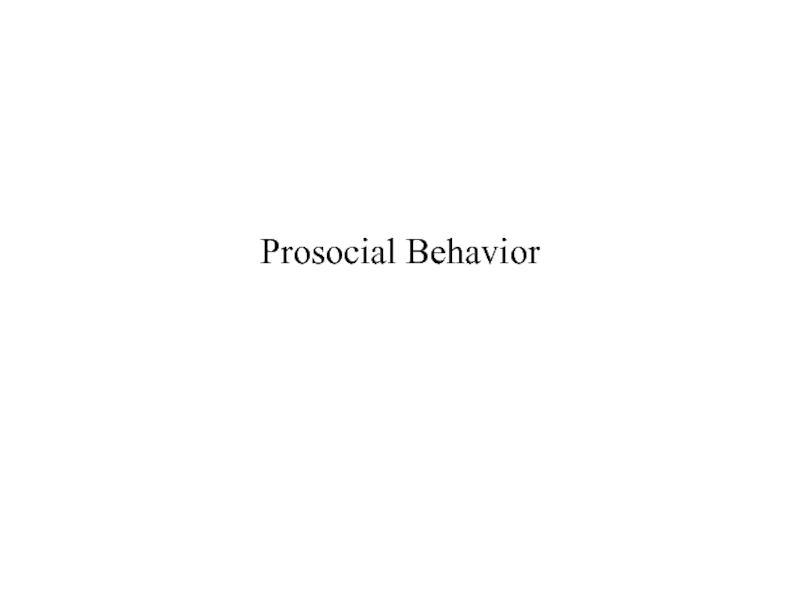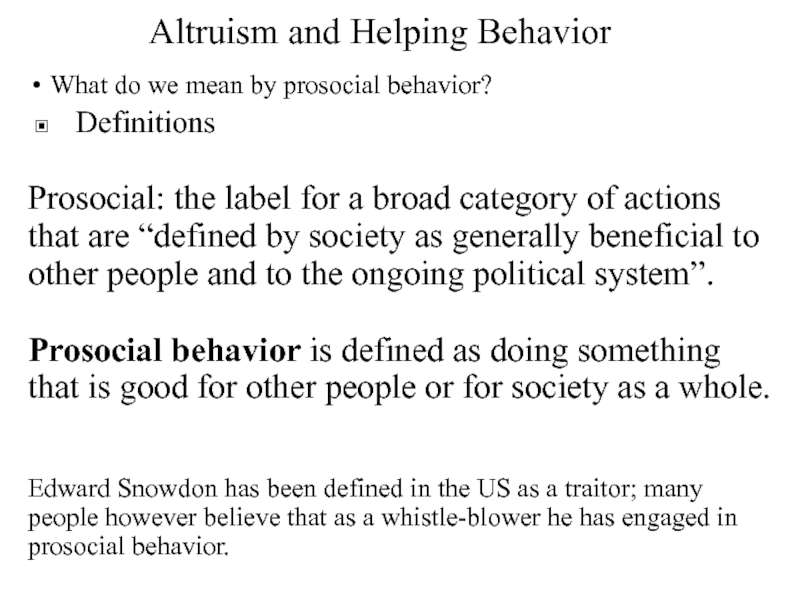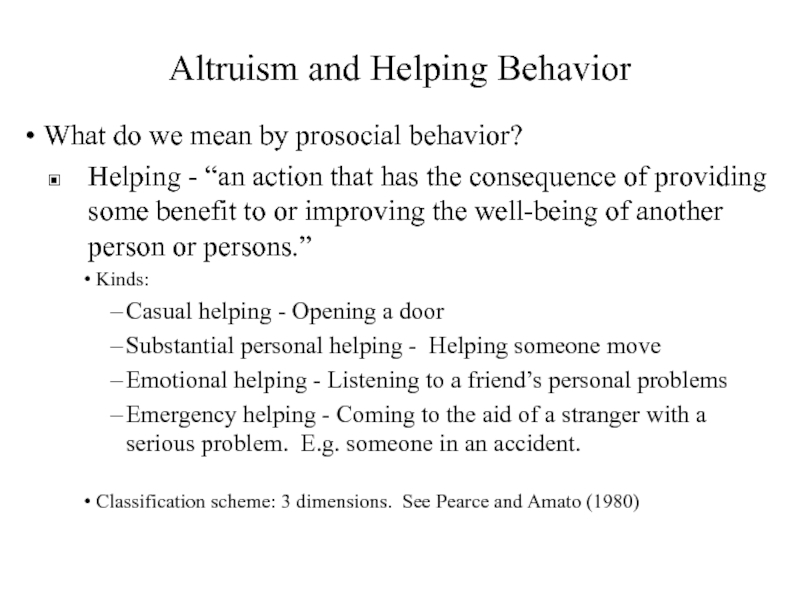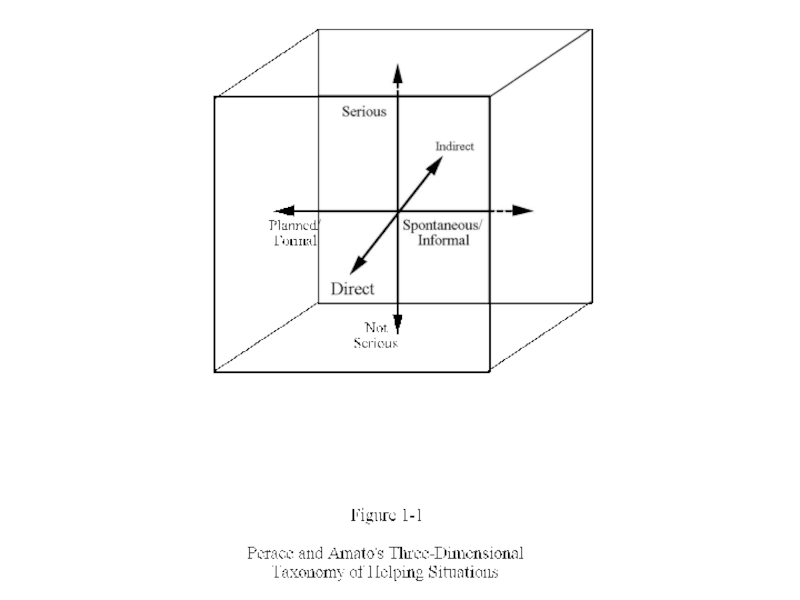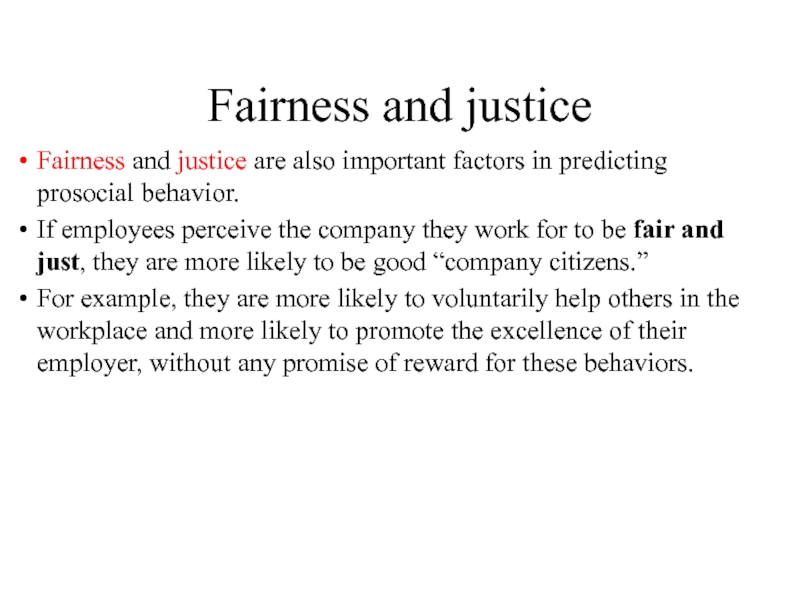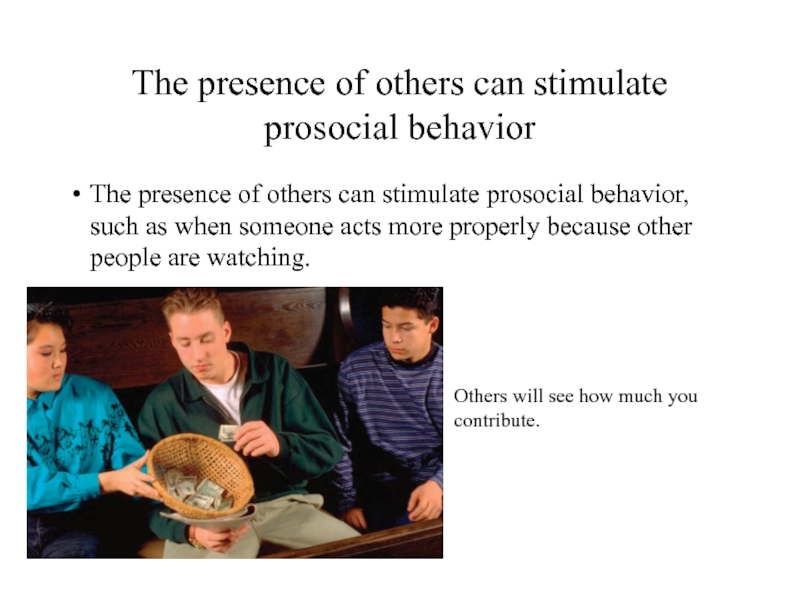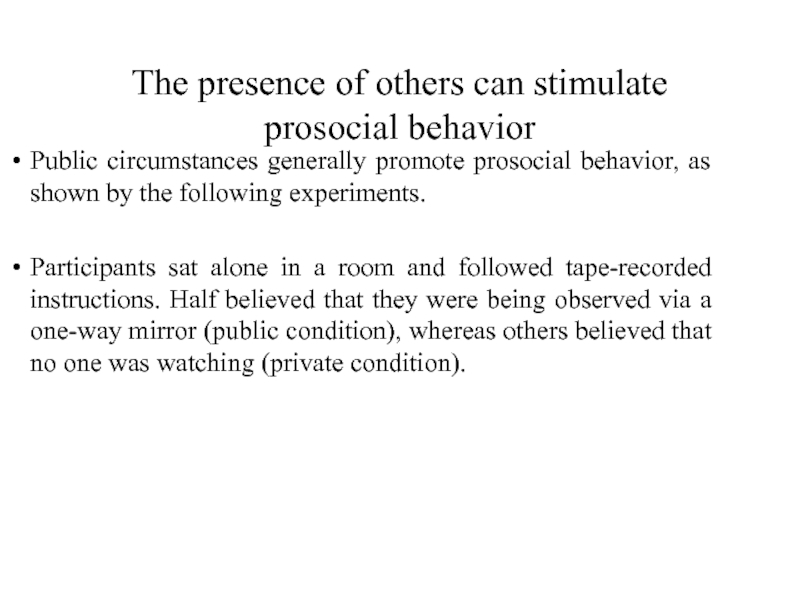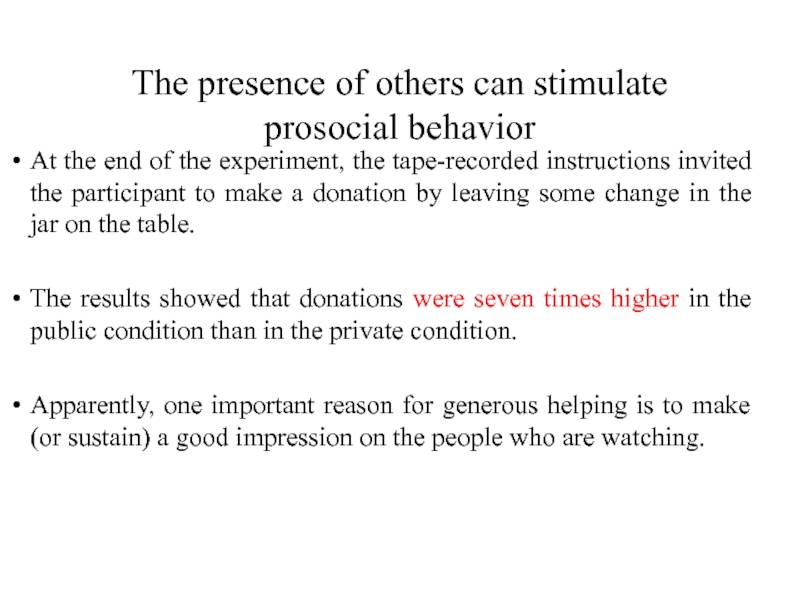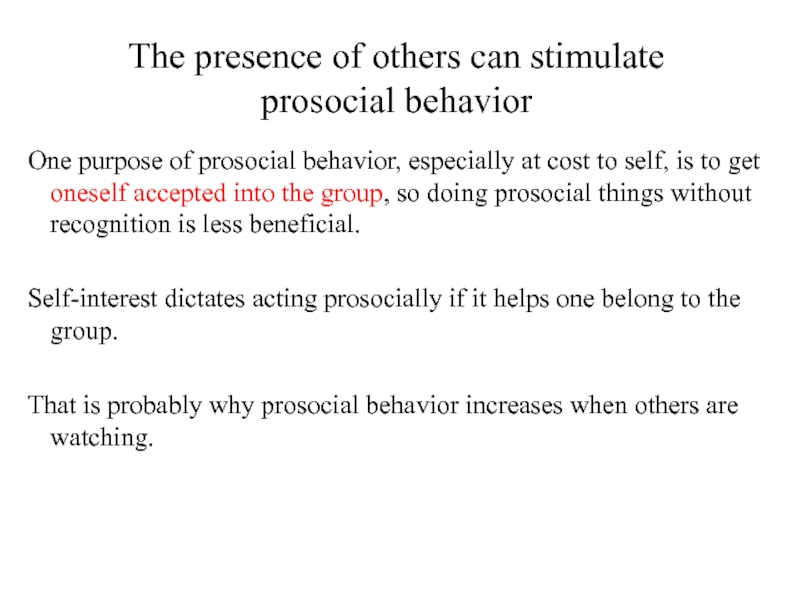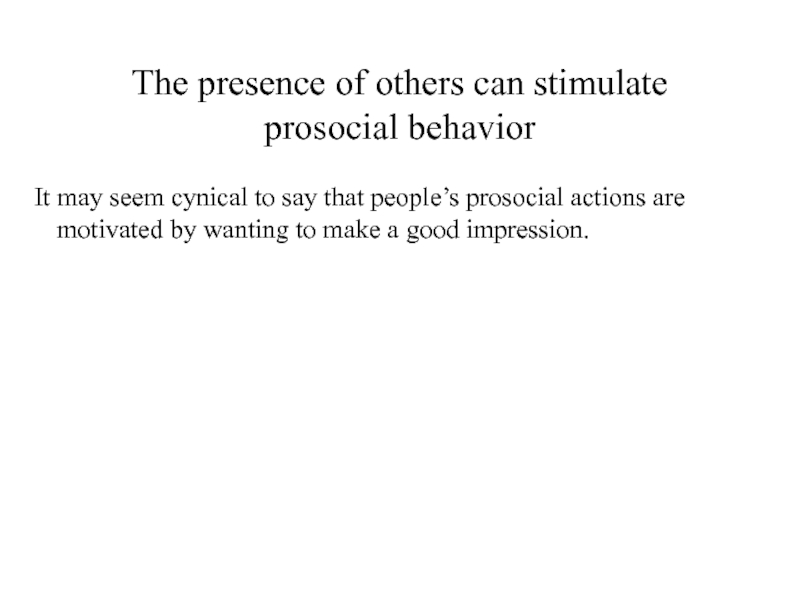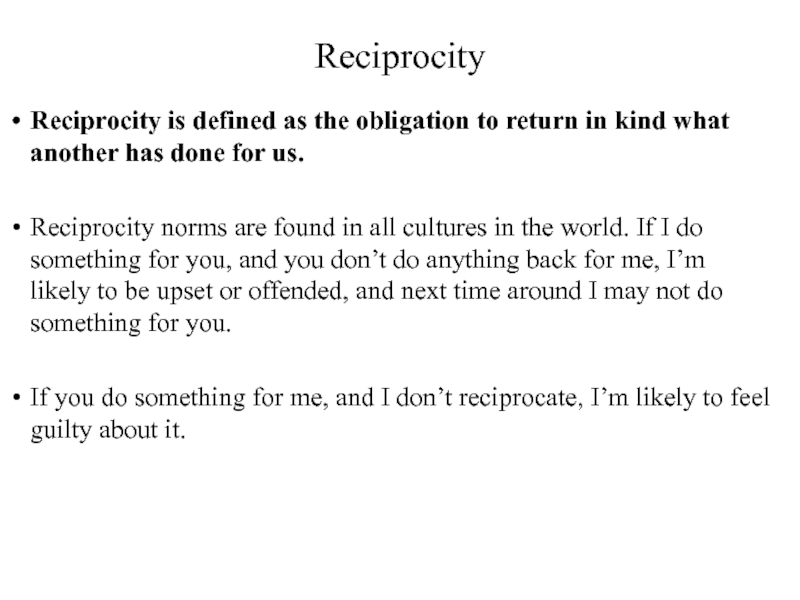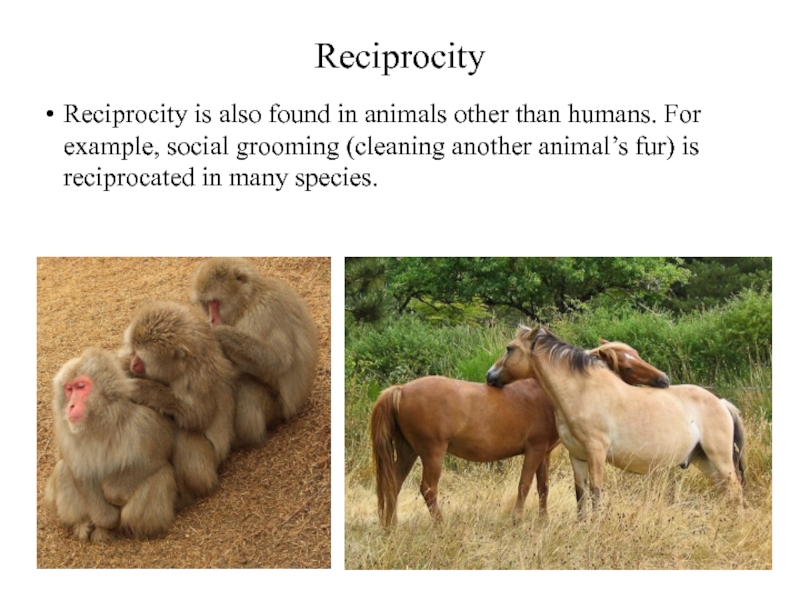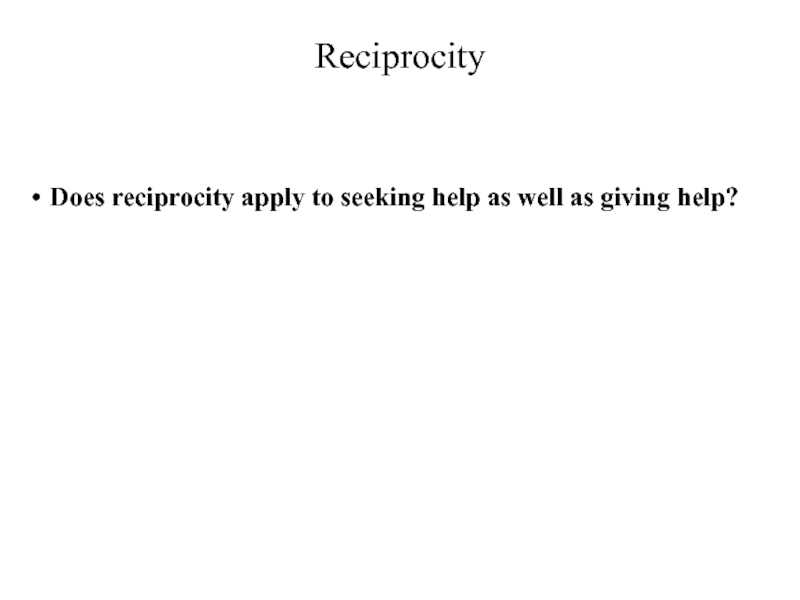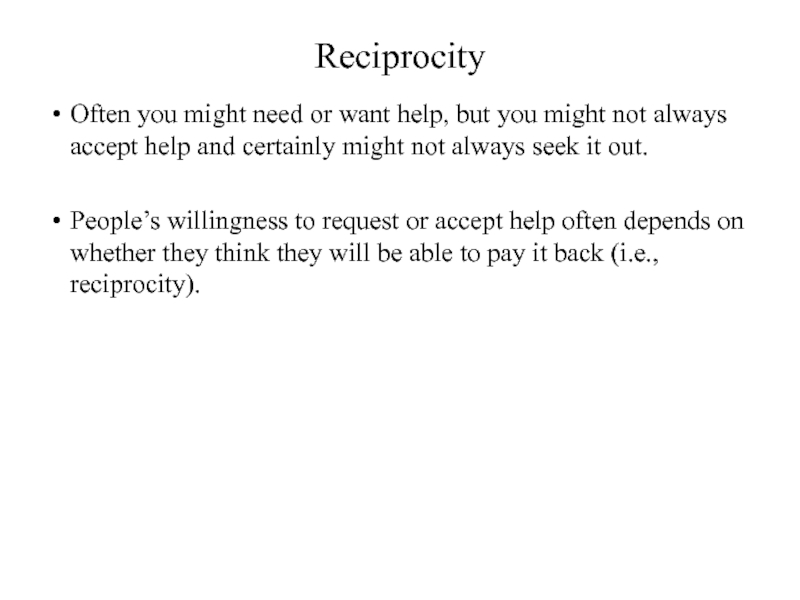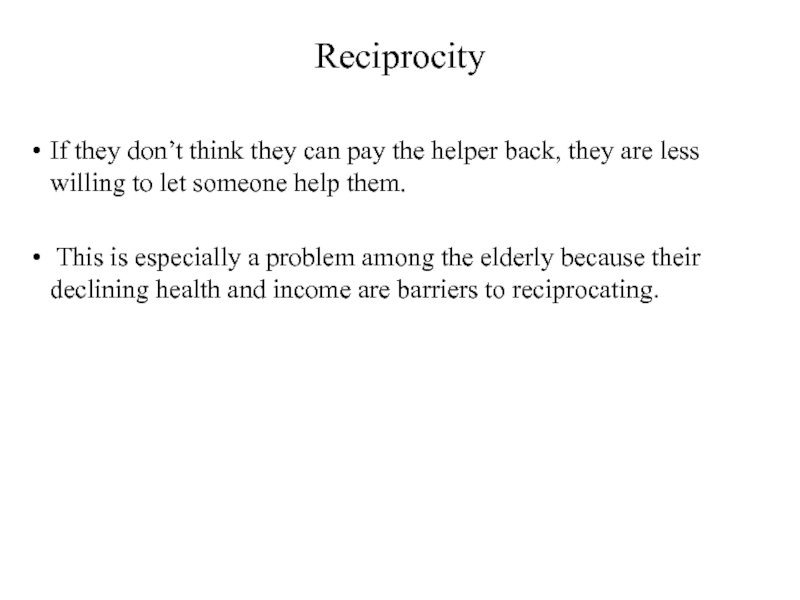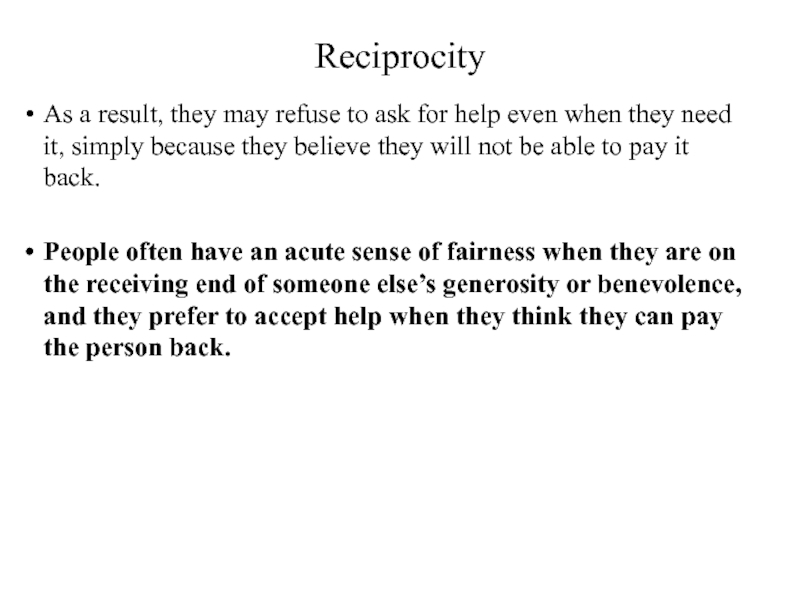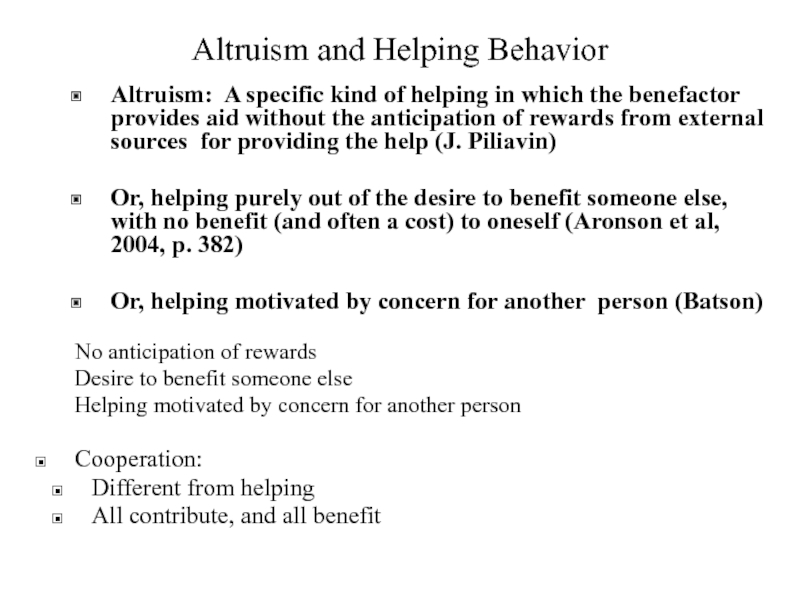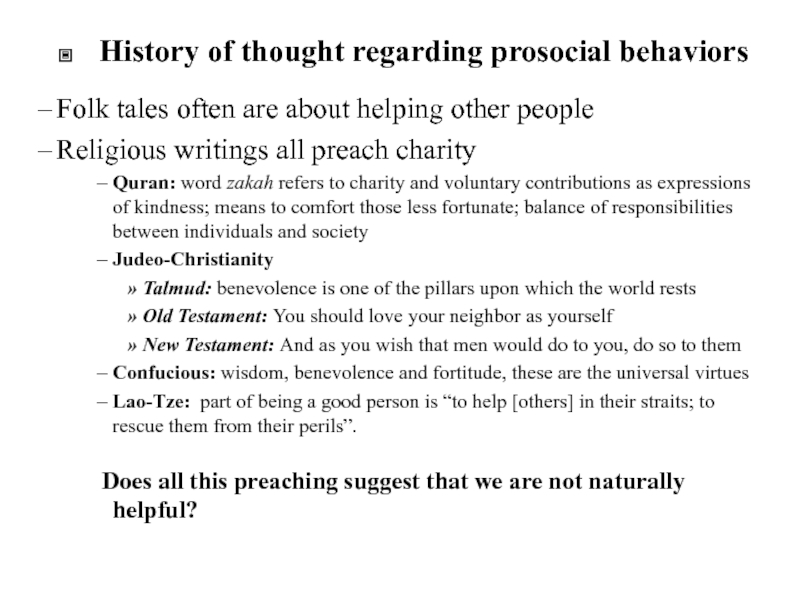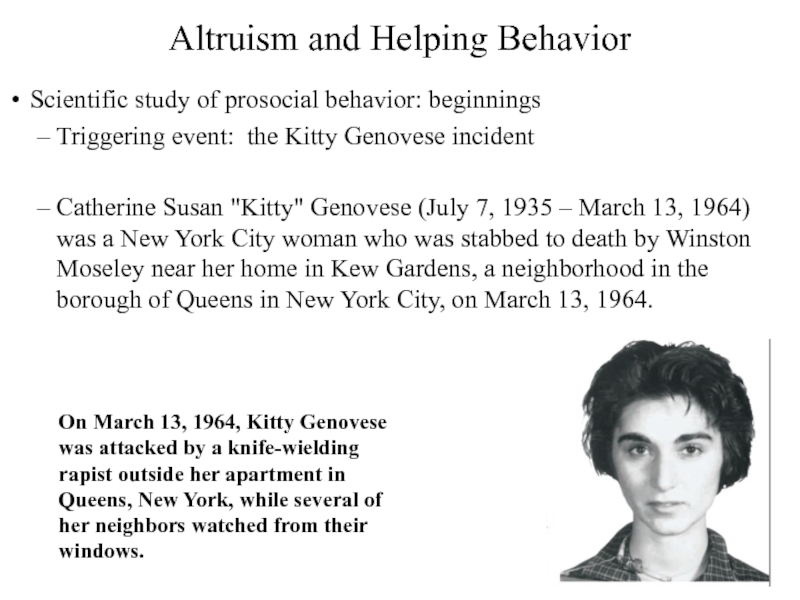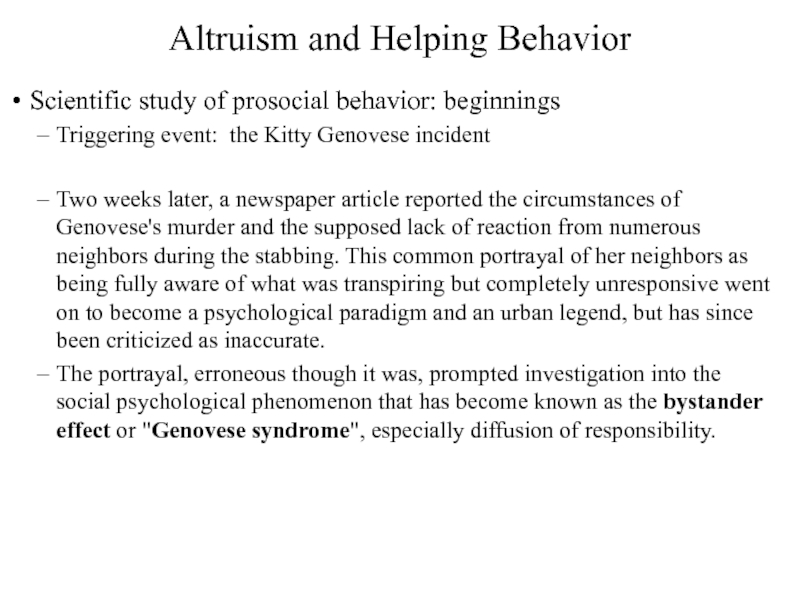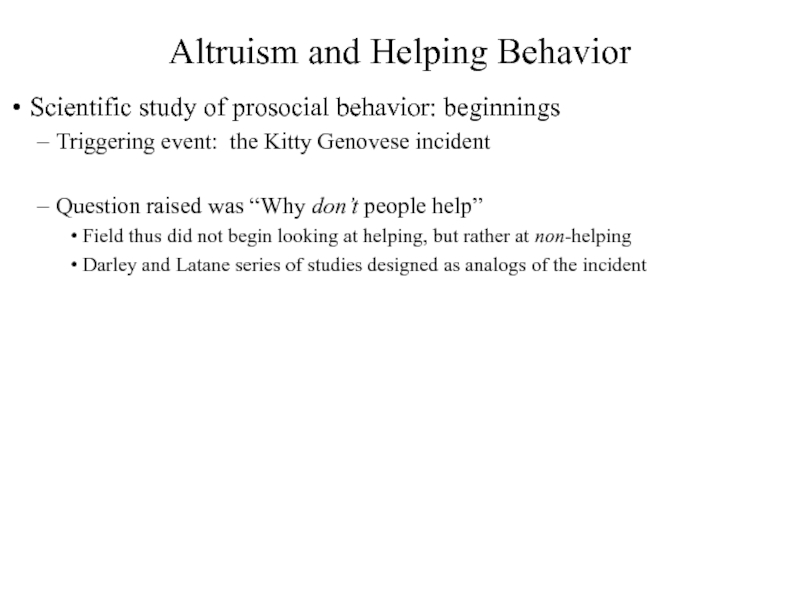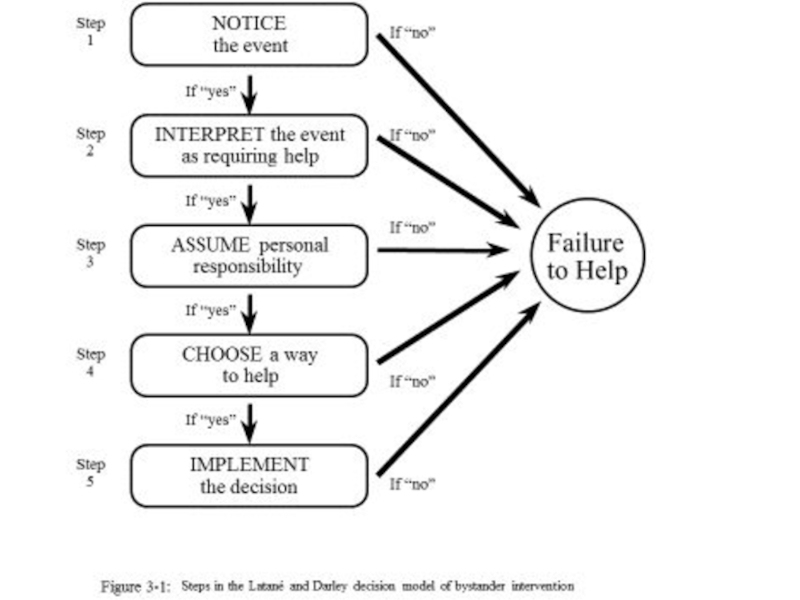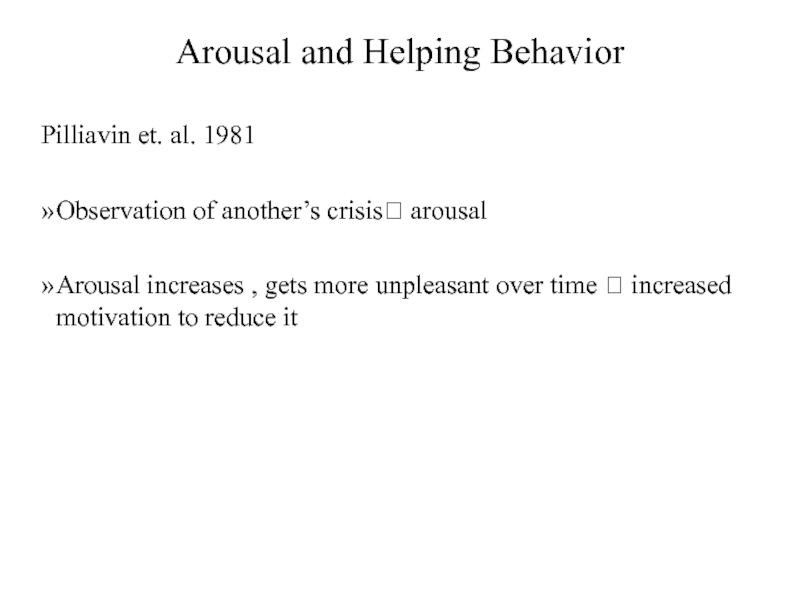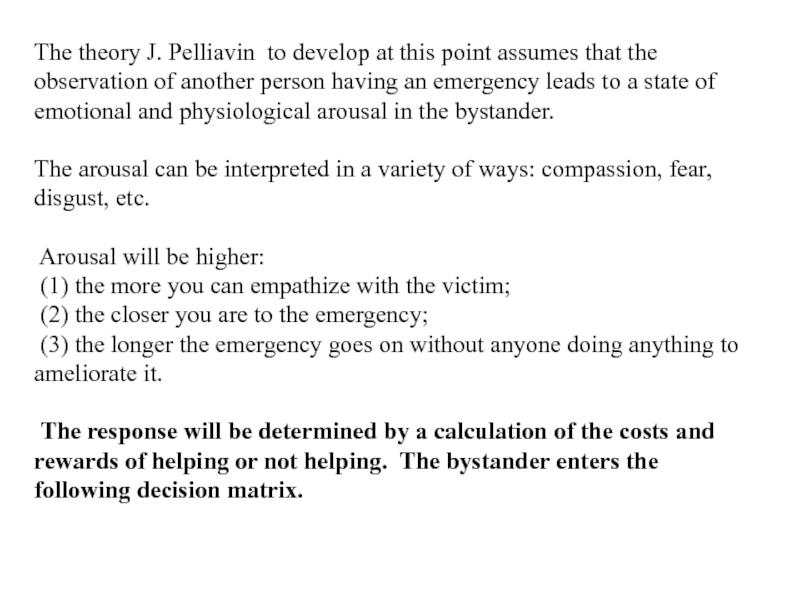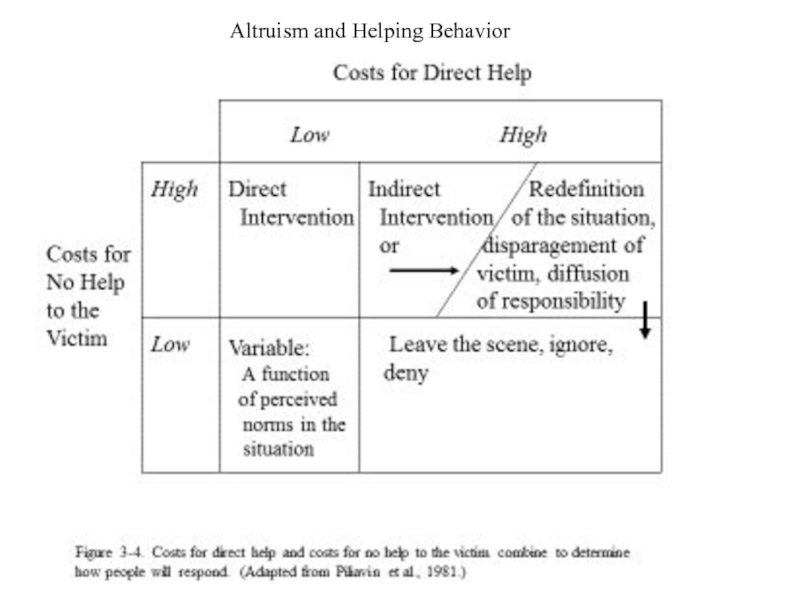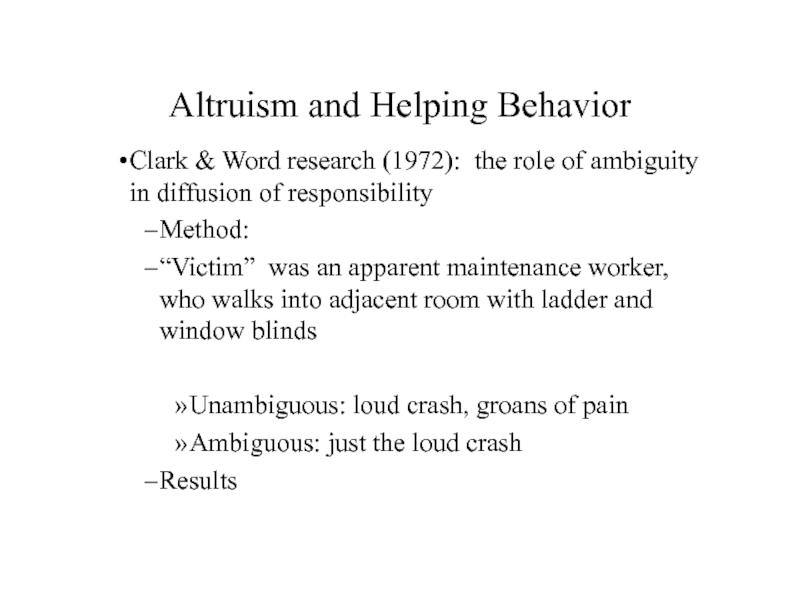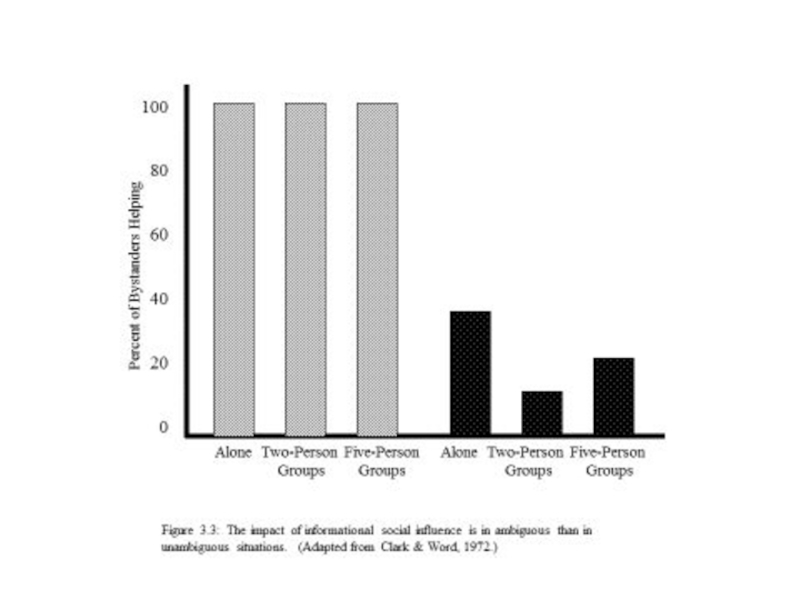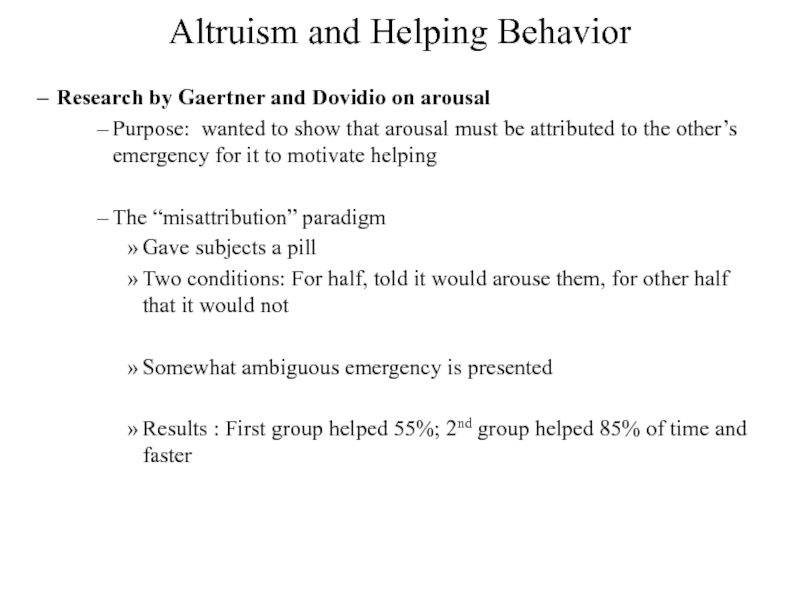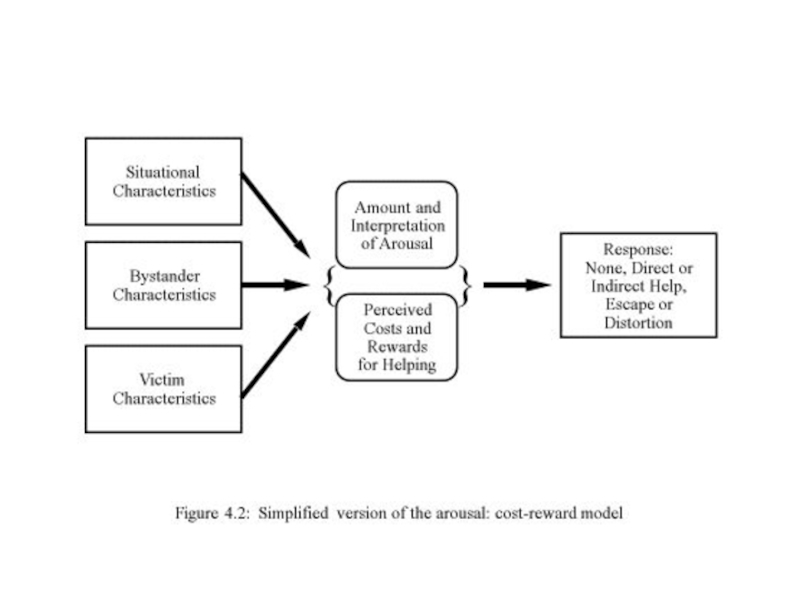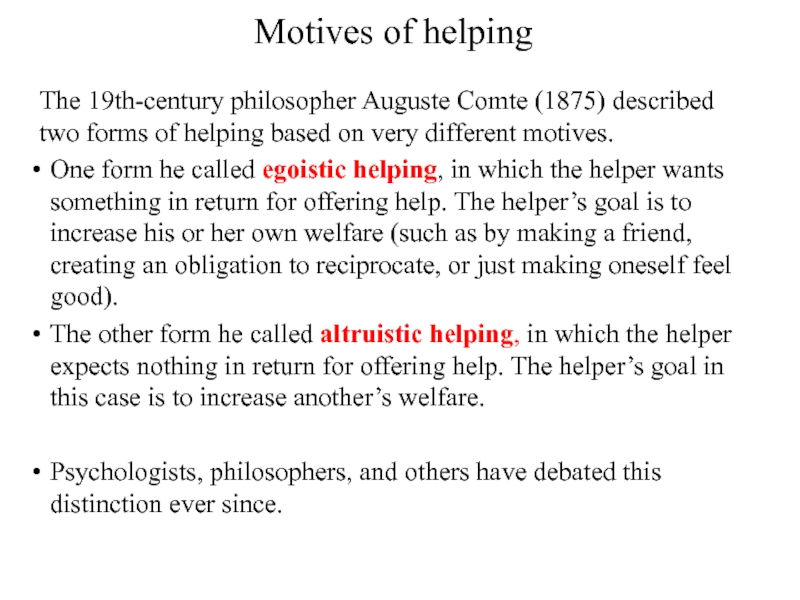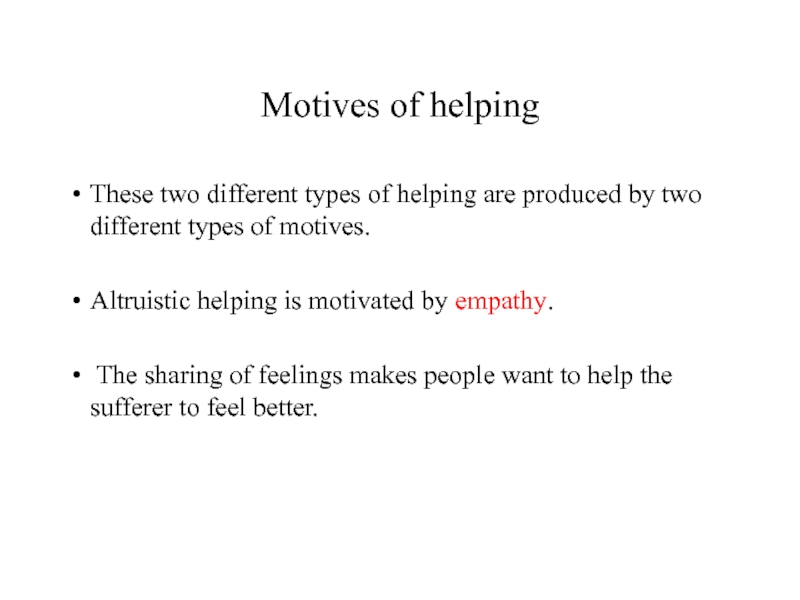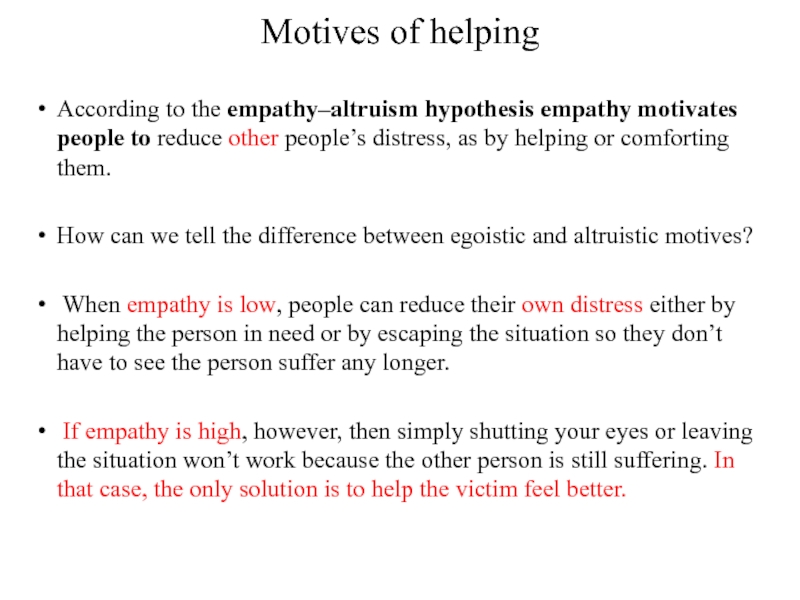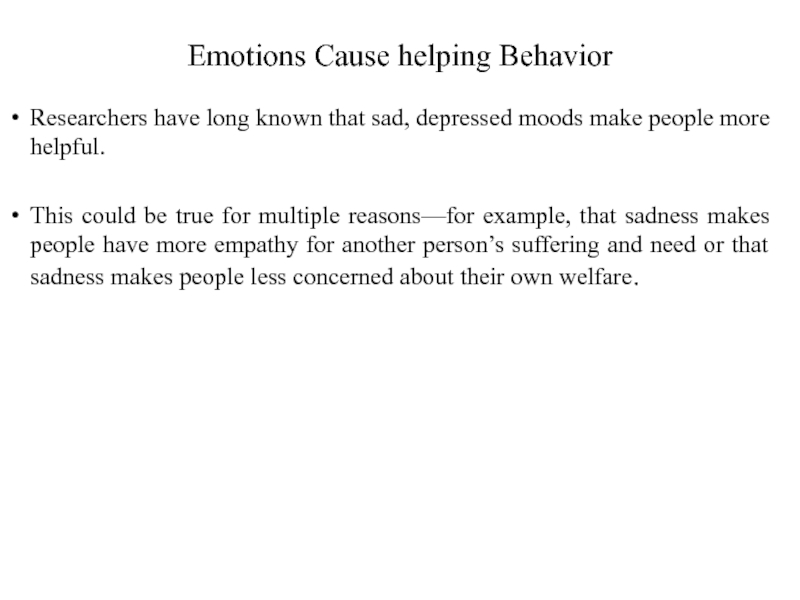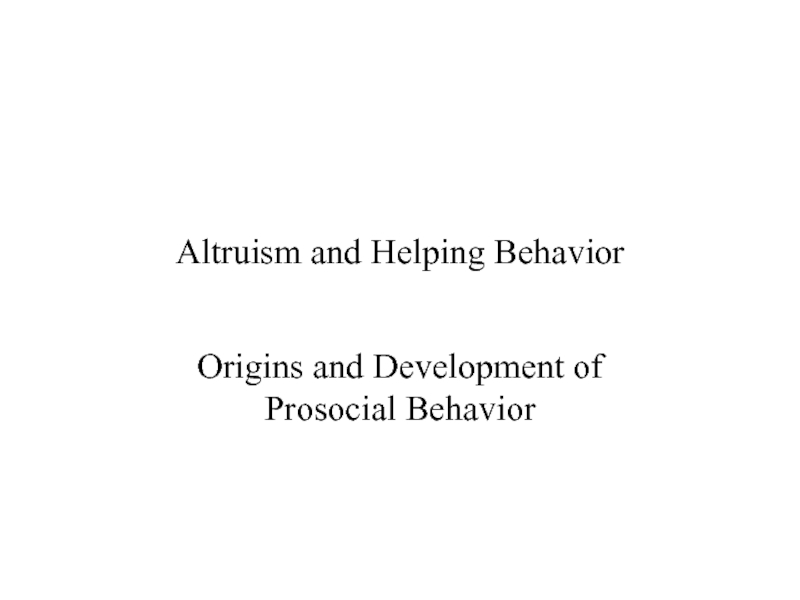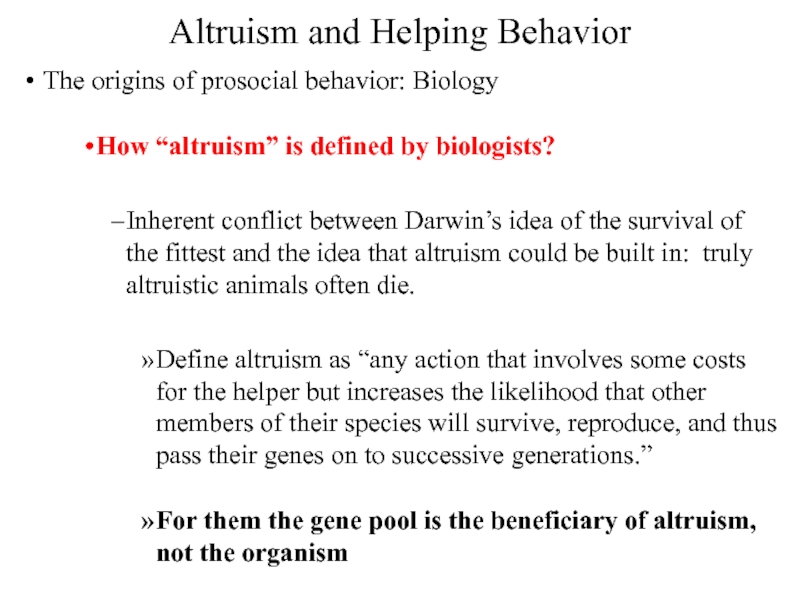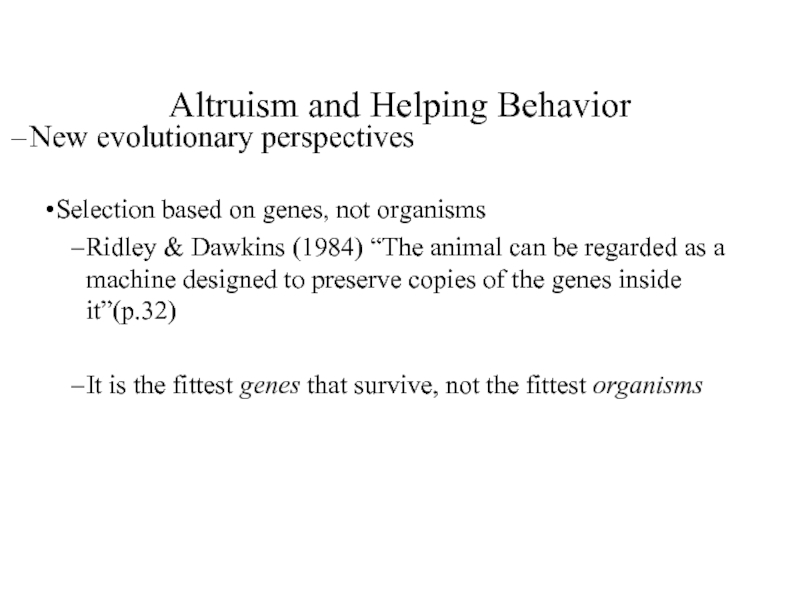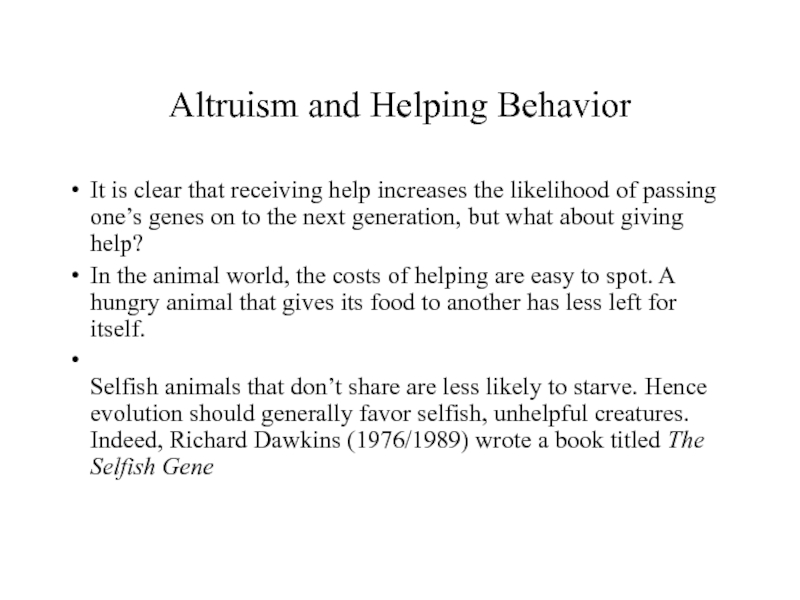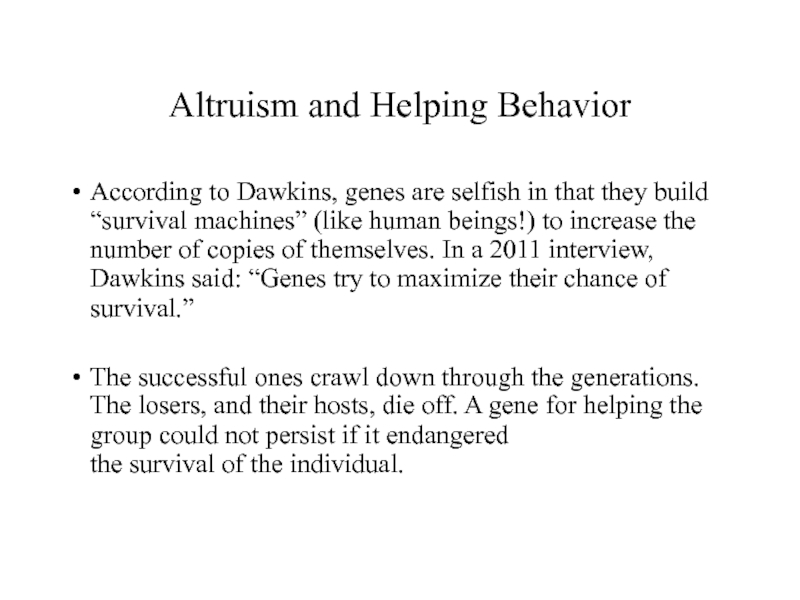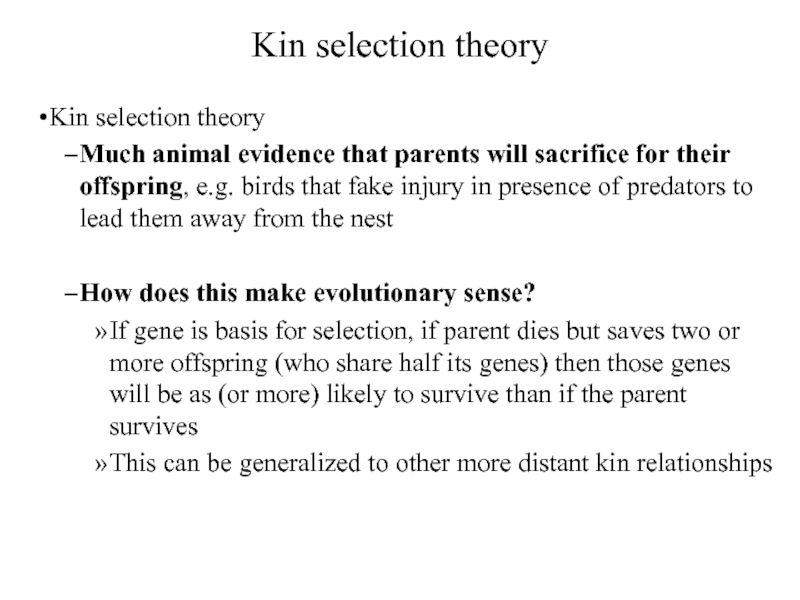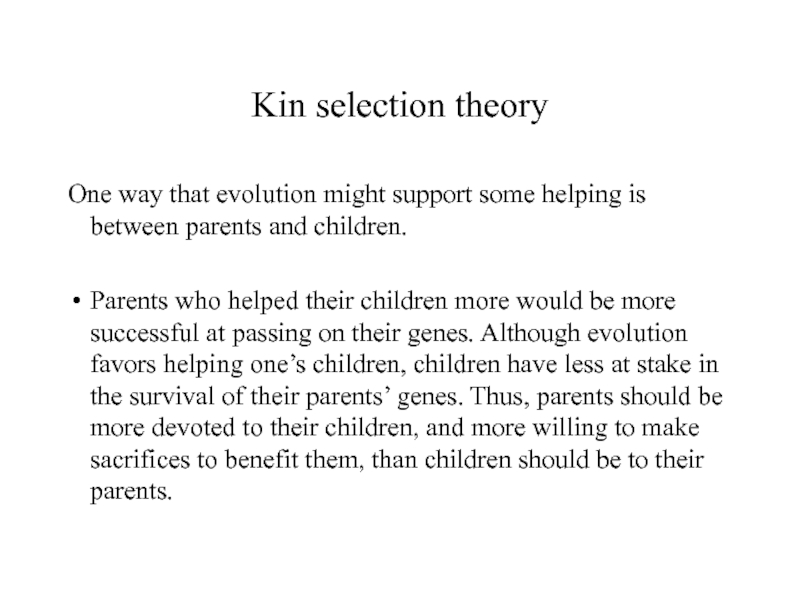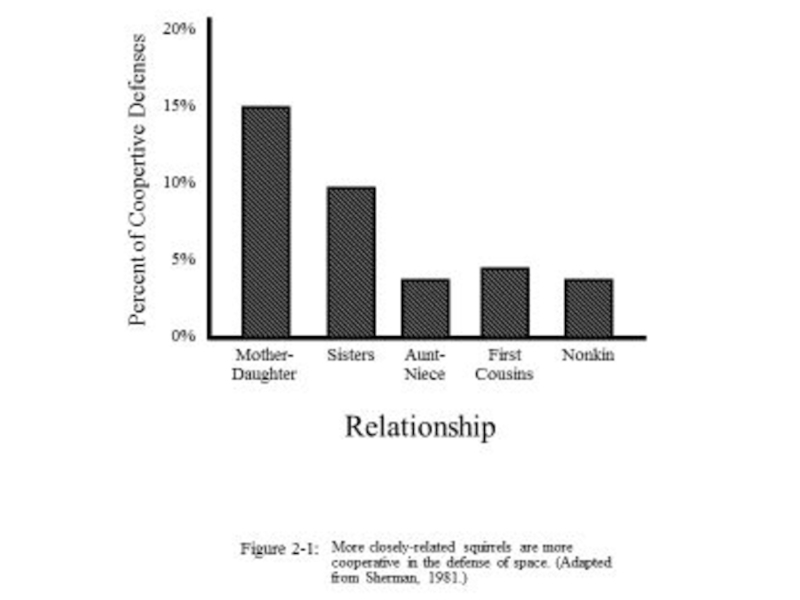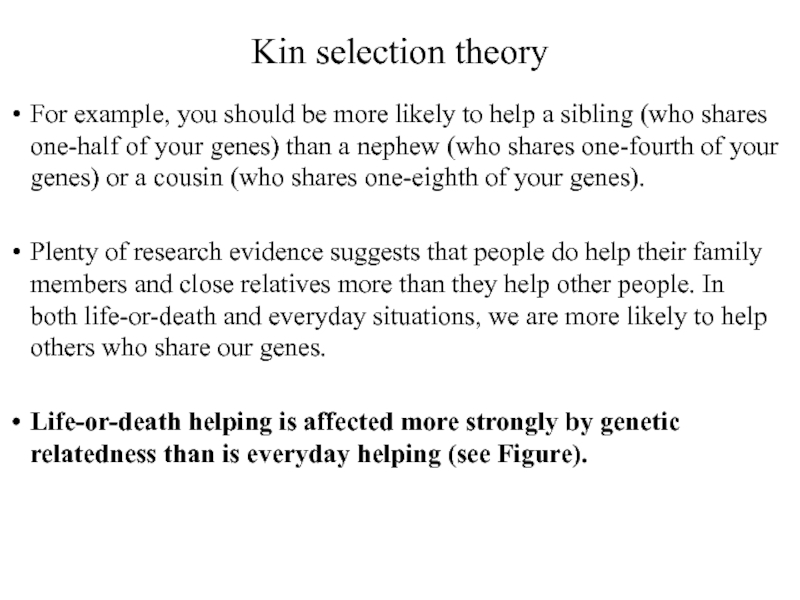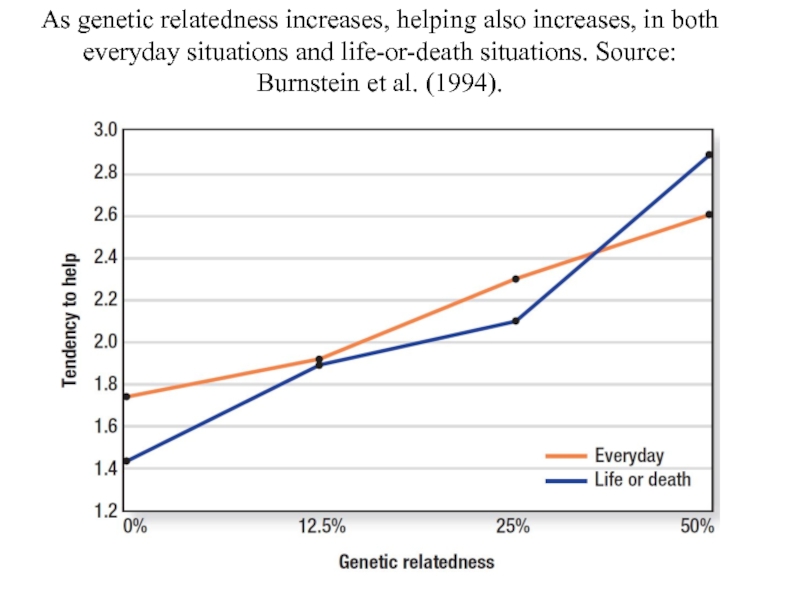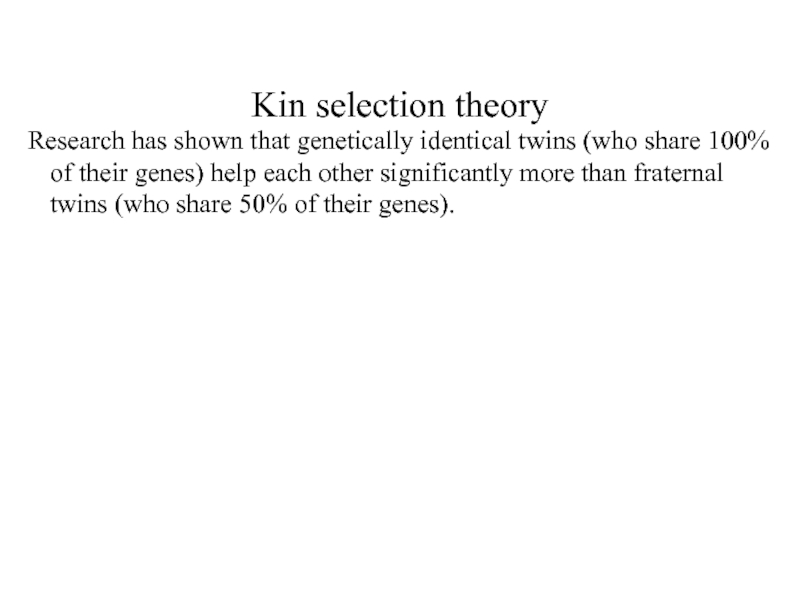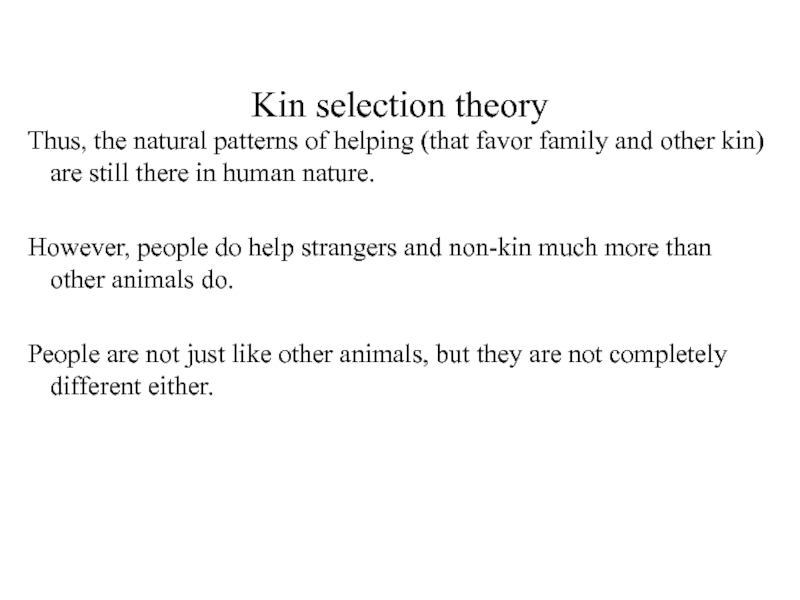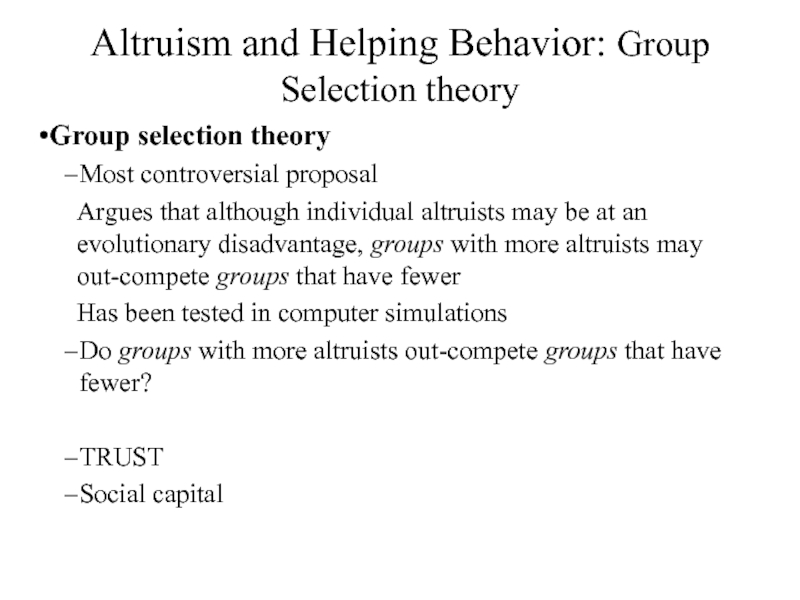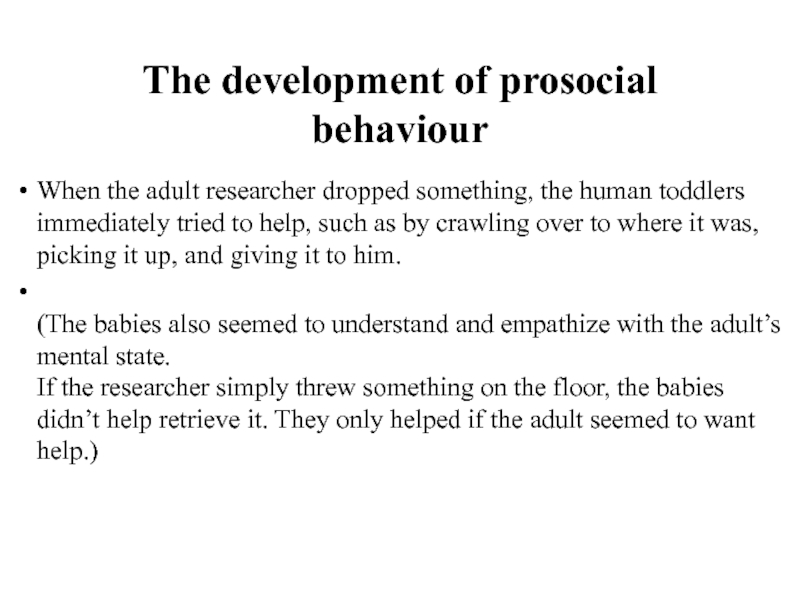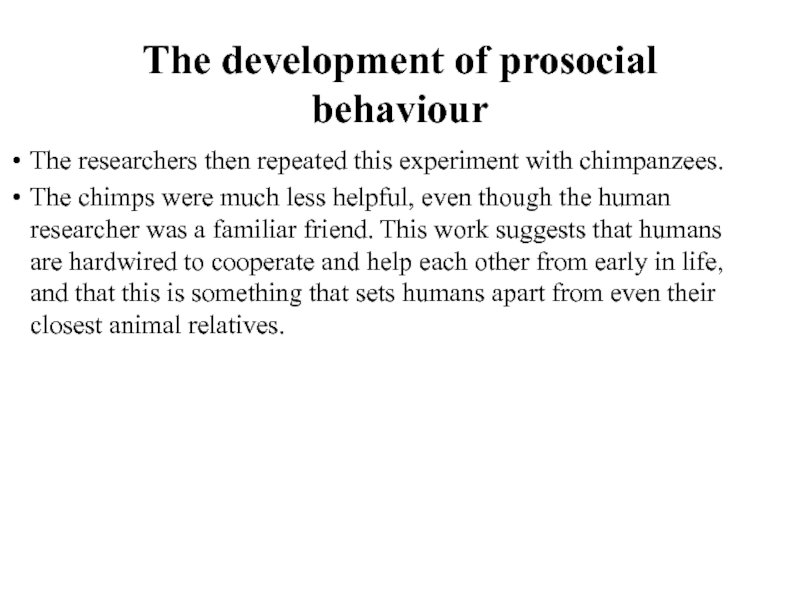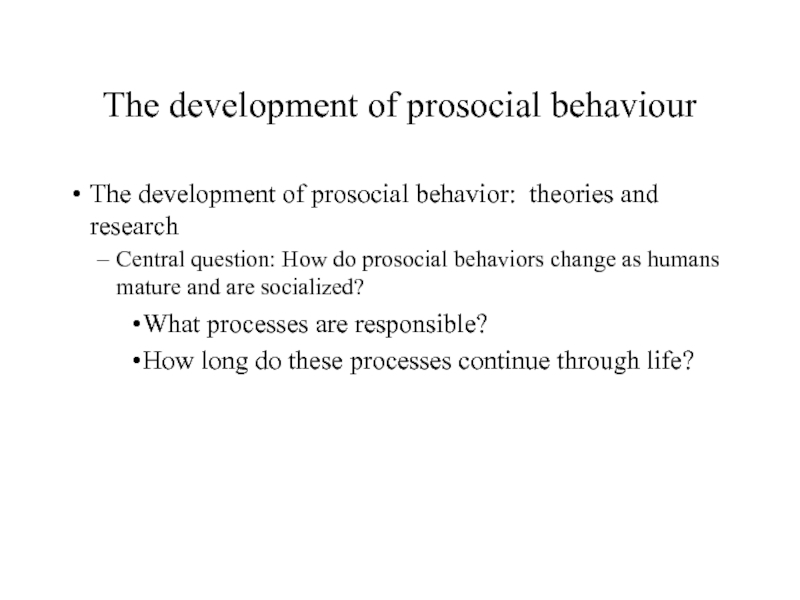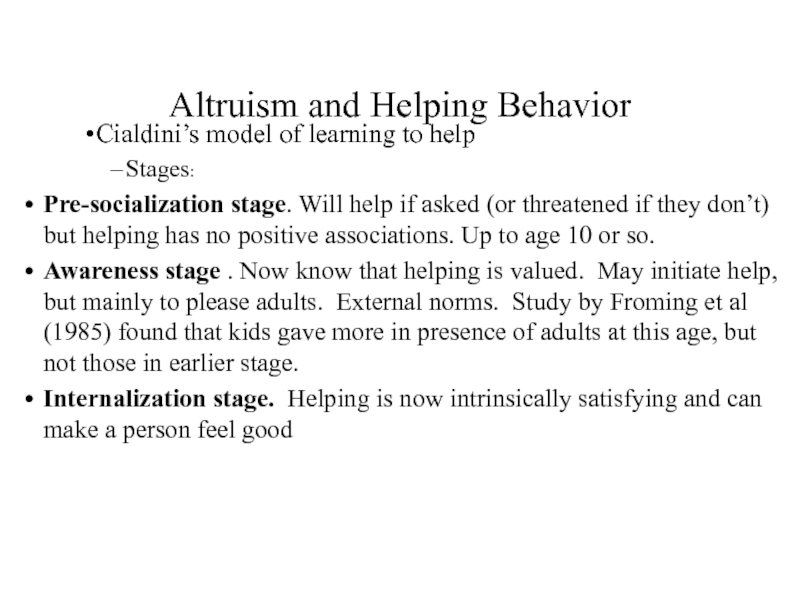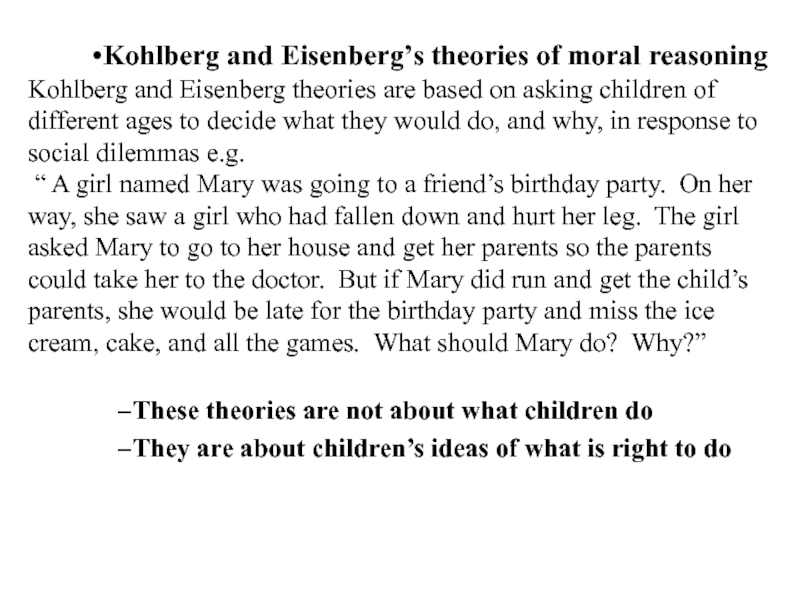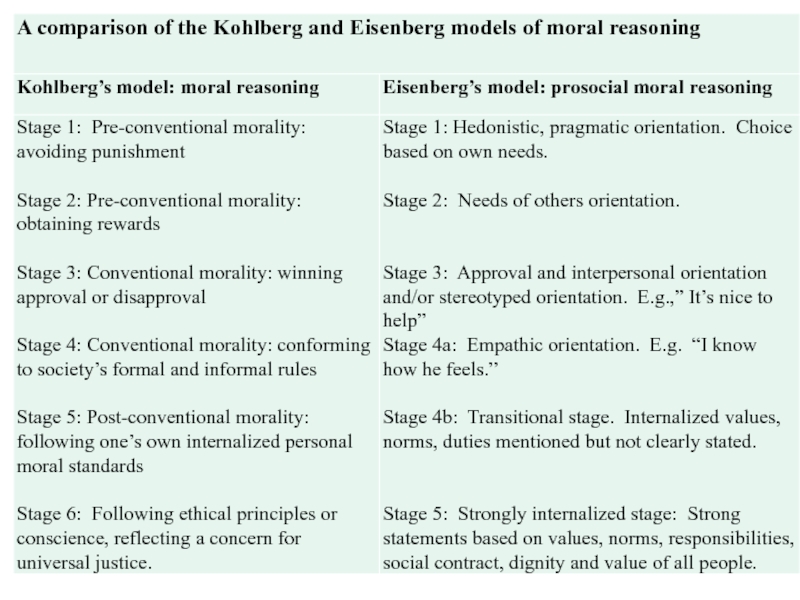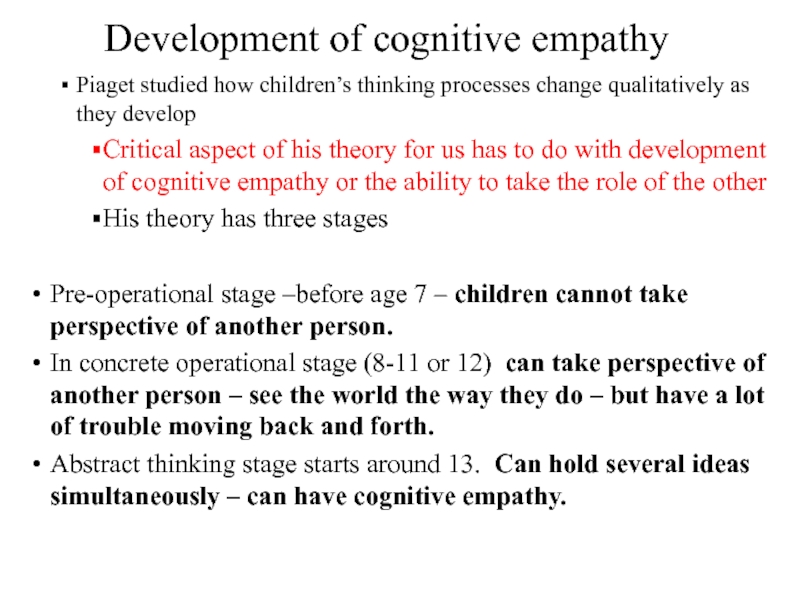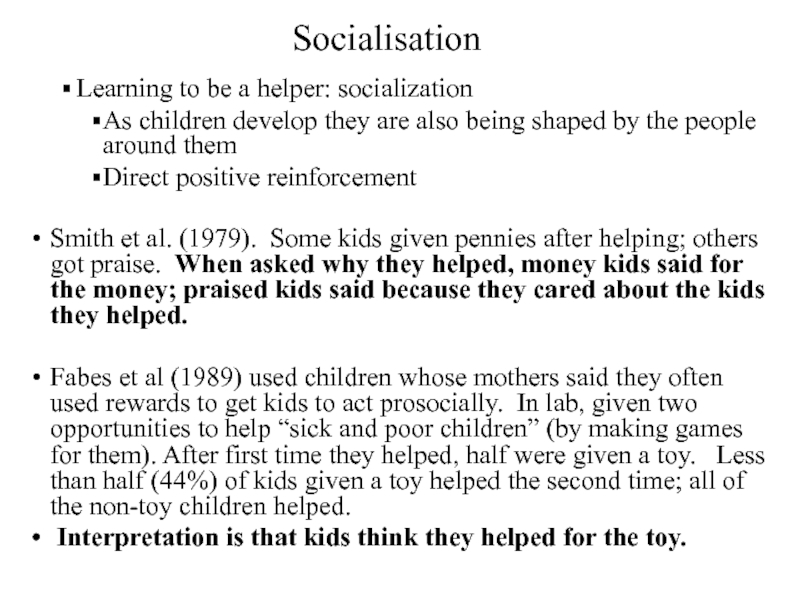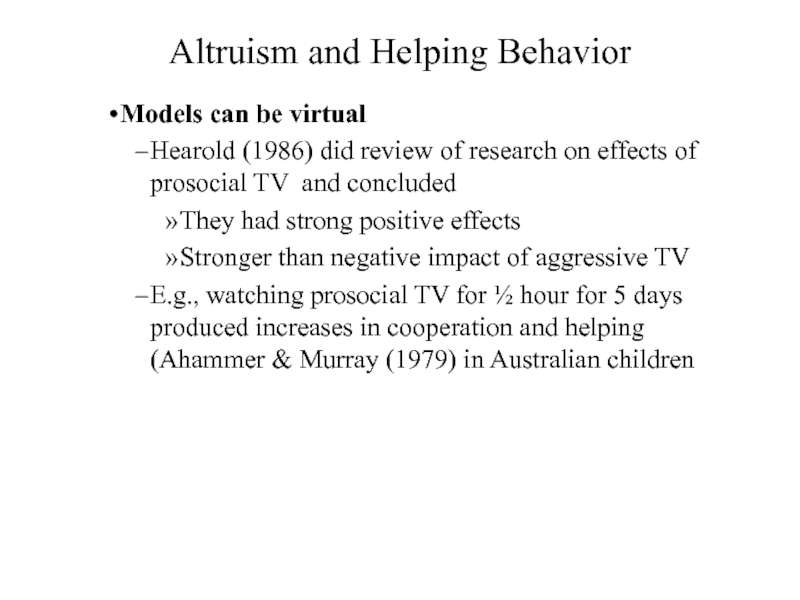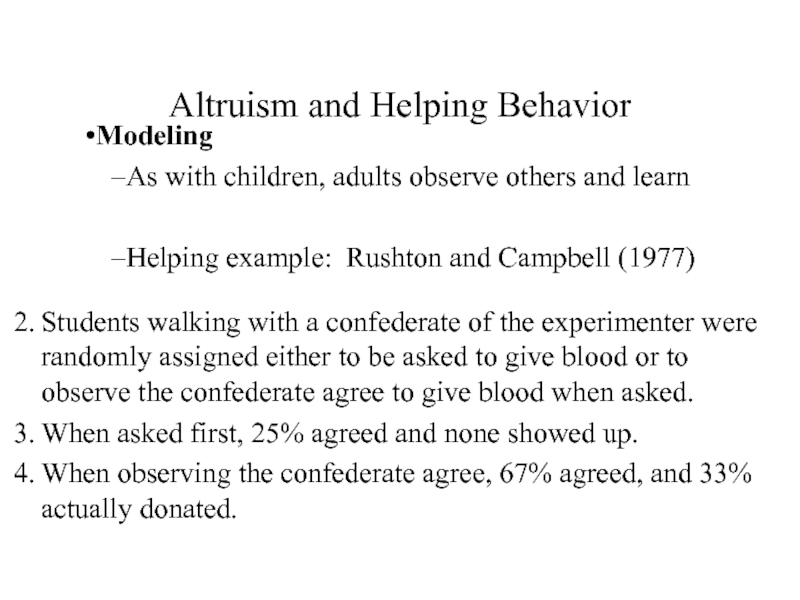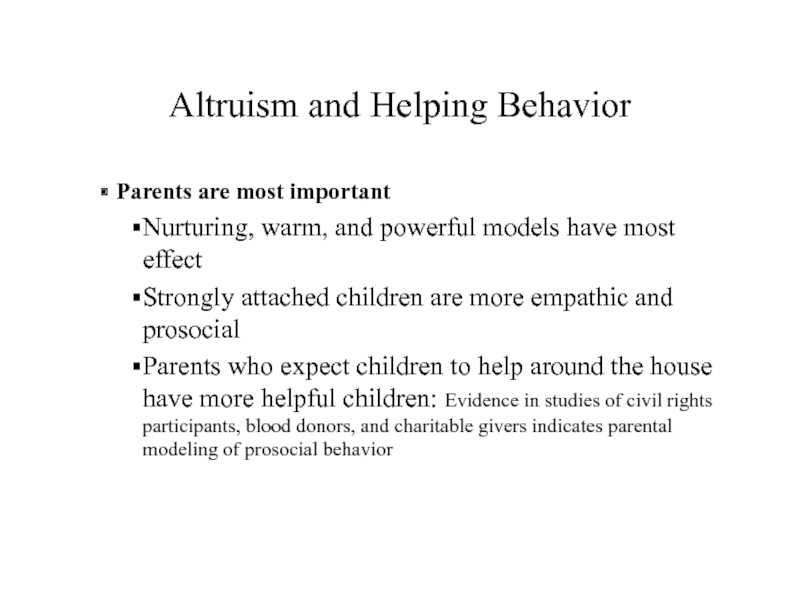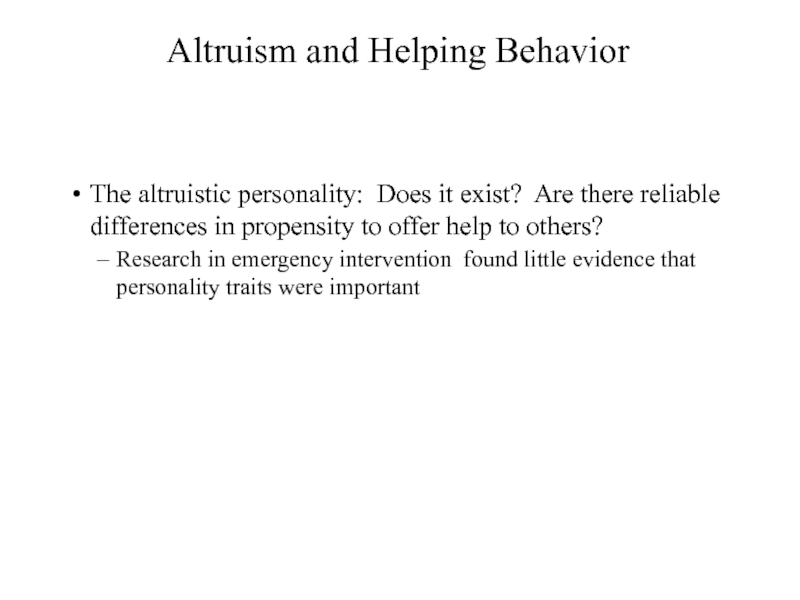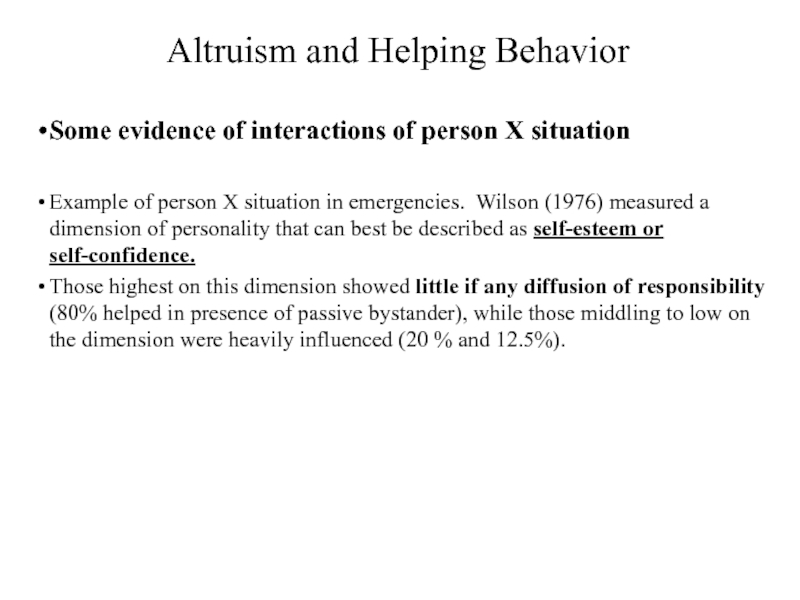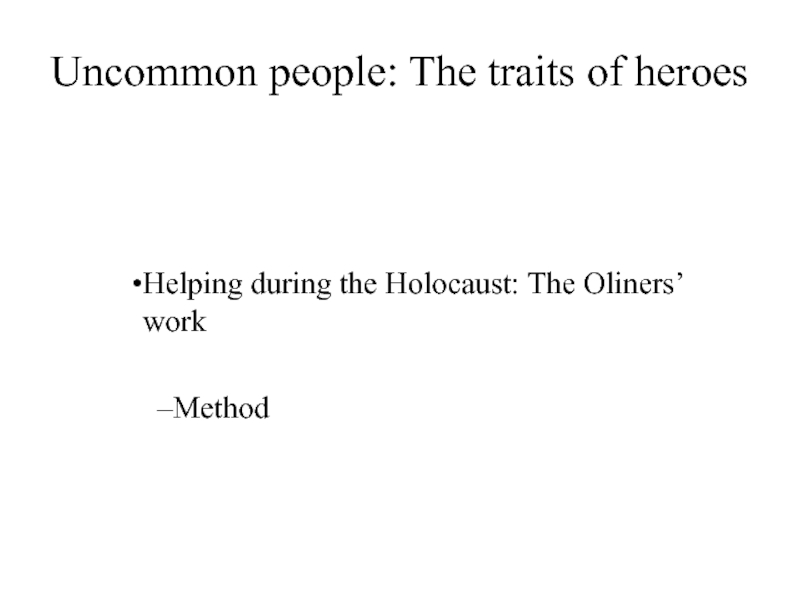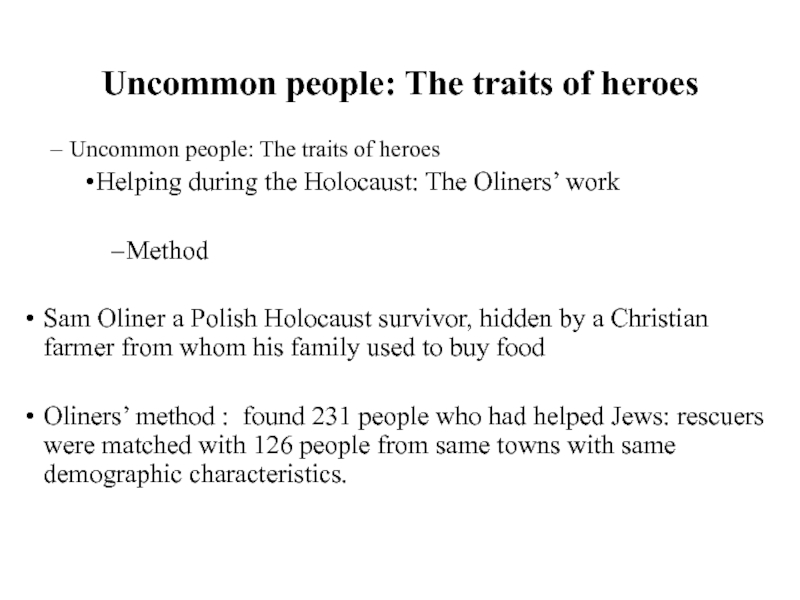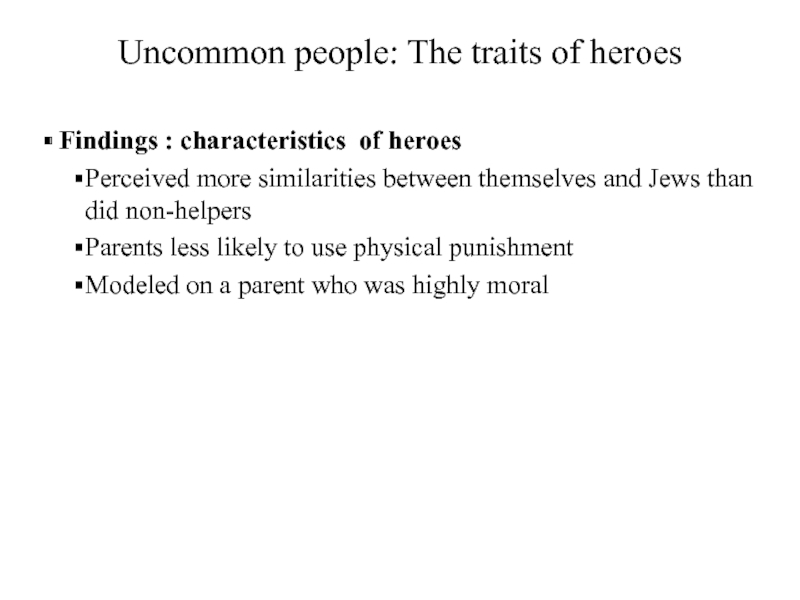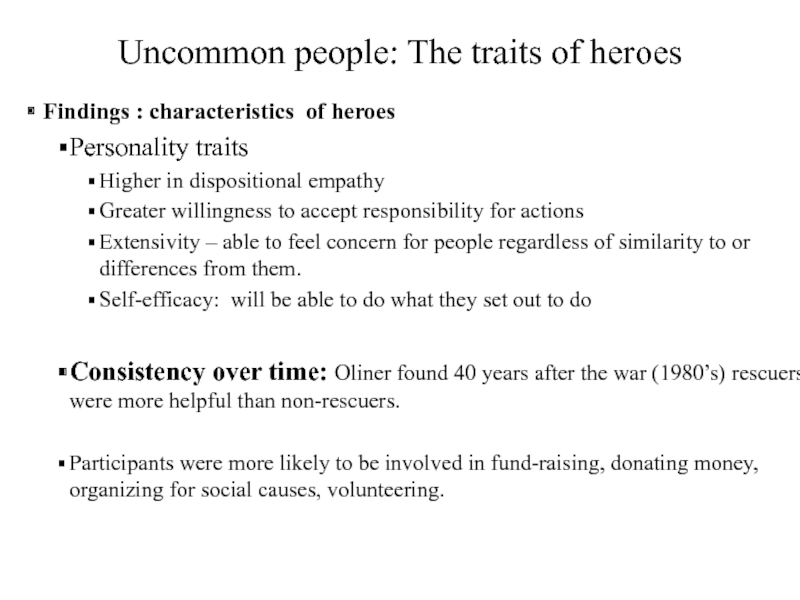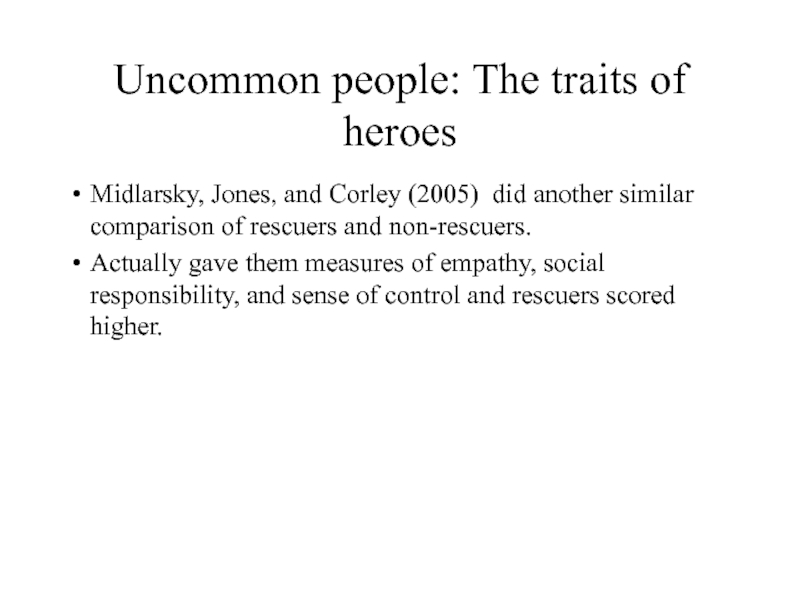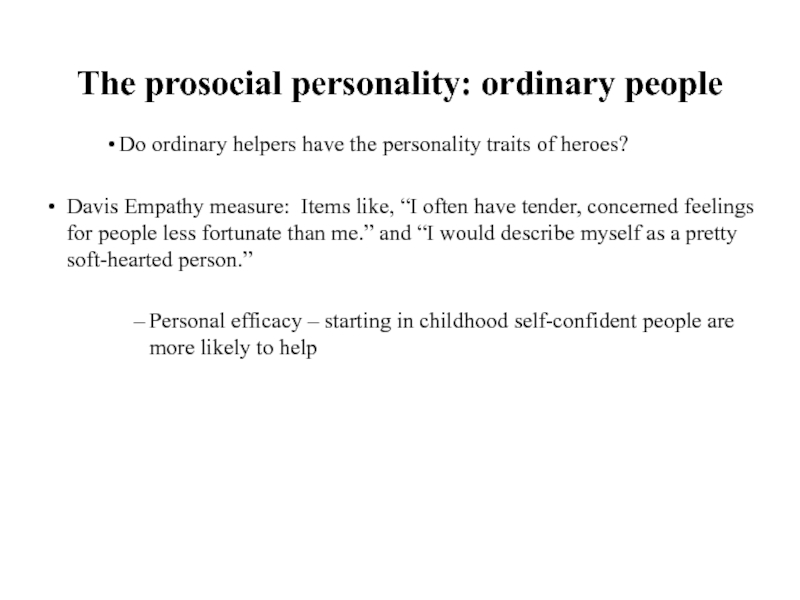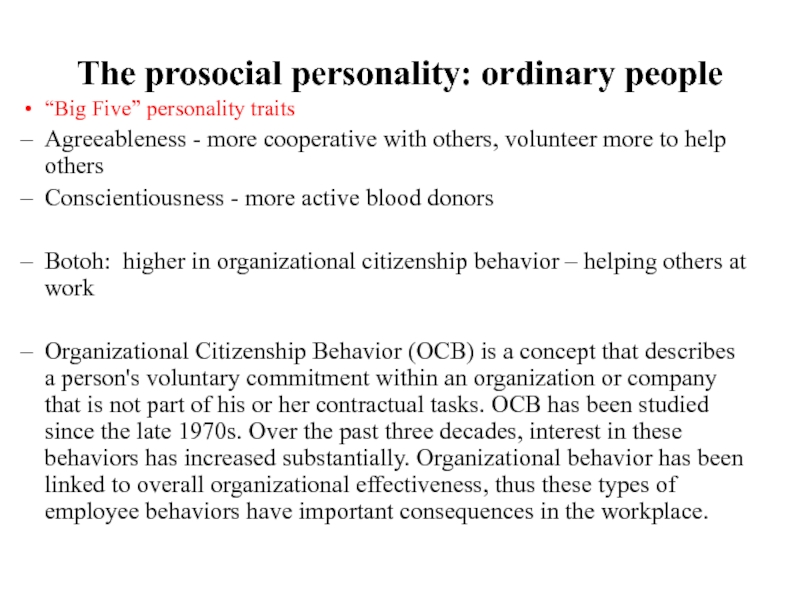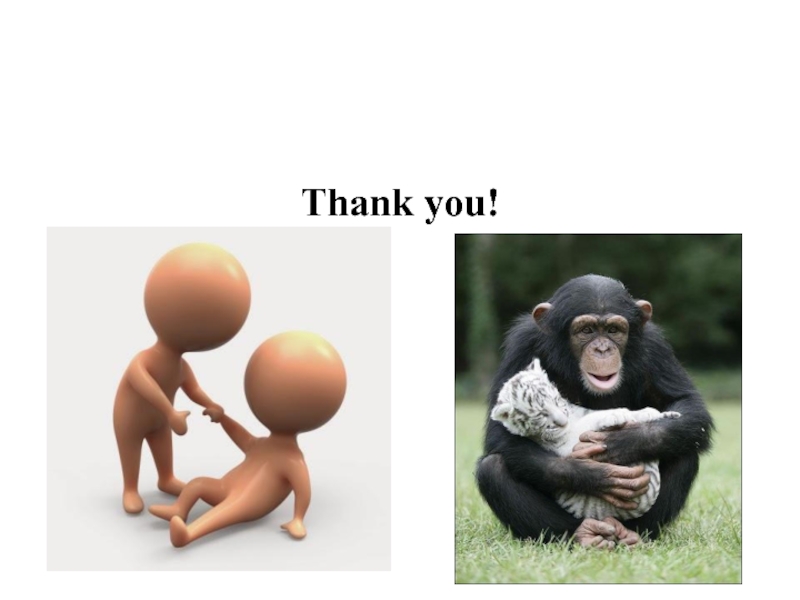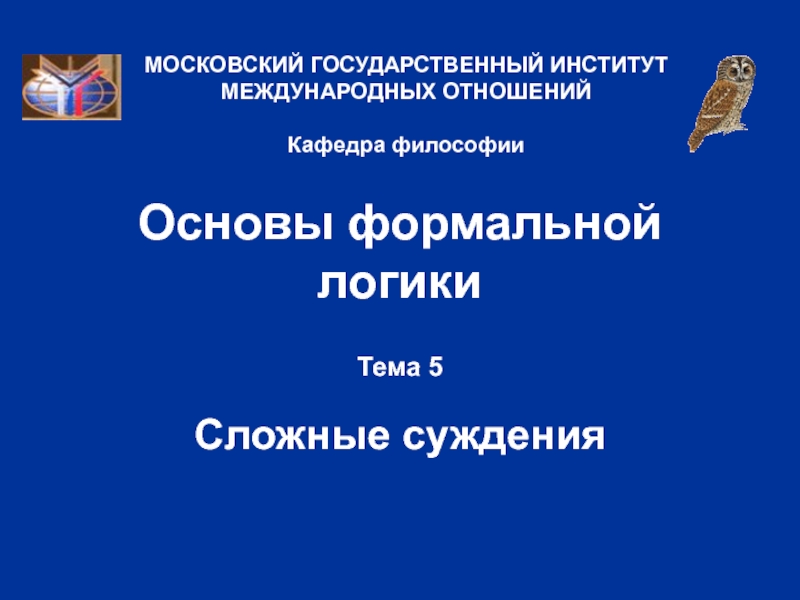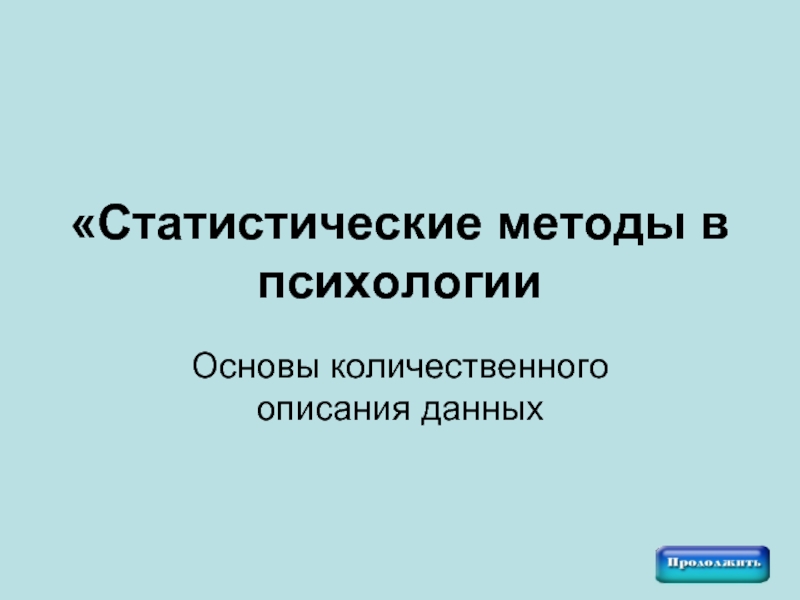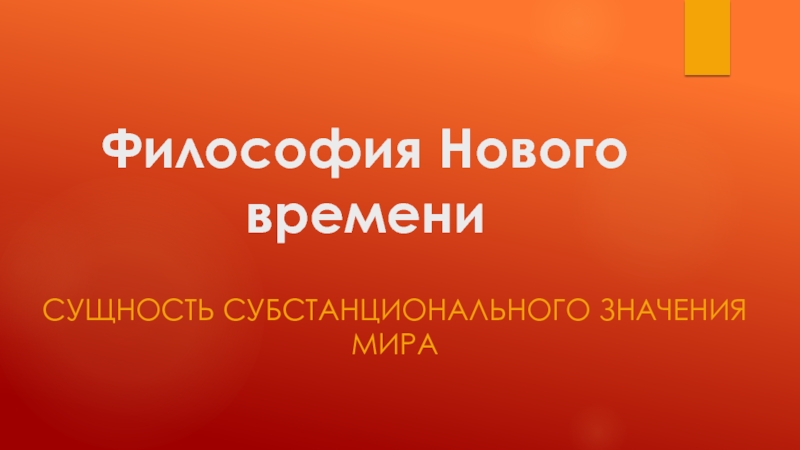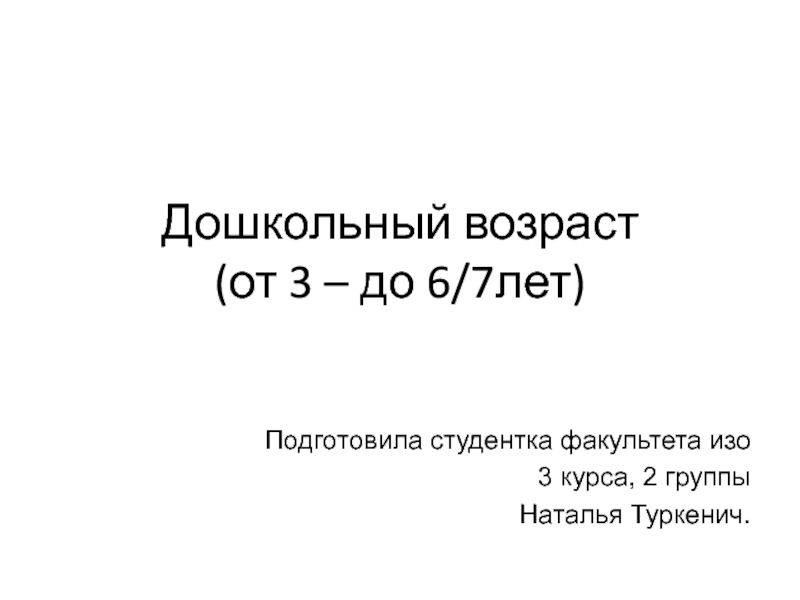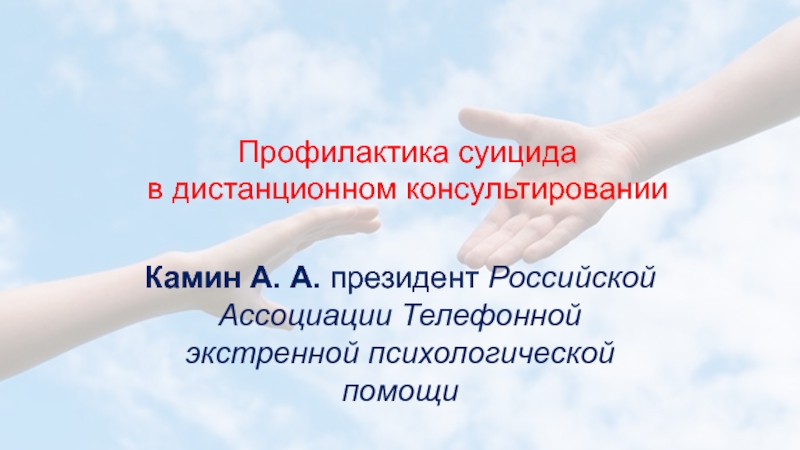- Главная
- Разное
- Дизайн
- Бизнес и предпринимательство
- Аналитика
- Образование
- Развлечения
- Красота и здоровье
- Финансы
- Государство
- Путешествия
- Спорт
- Недвижимость
- Армия
- Графика
- Культурология
- Еда и кулинария
- Лингвистика
- Английский язык
- Астрономия
- Алгебра
- Биология
- География
- Детские презентации
- Информатика
- История
- Литература
- Маркетинг
- Математика
- Медицина
- Менеджмент
- Музыка
- МХК
- Немецкий язык
- ОБЖ
- Обществознание
- Окружающий мир
- Педагогика
- Русский язык
- Технология
- Физика
- Философия
- Химия
- Шаблоны, картинки для презентаций
- Экология
- Экономика
- Юриспруденция
Prosocial Behavior презентация
Содержание
- 1. Prosocial Behavior
- 2. Altruism and Helping Behavior What do we
- 3. Altruism and Helping Behavior What do we
- 5. Fairness and justice Fairness and justice are
- 6. The presence of others can stimulate prosocial
- 7. The presence of others can stimulate prosocial
- 8. The presence of others can stimulate prosocial
- 9. The presence of others can stimulate prosocial
- 10. The presence of others can stimulate prosocial
- 11. Reciprocity Reciprocity is defined as the
- 12. Reciprocity Reciprocity is also found in
- 13. Reciprocity Does reciprocity apply to seeking help as well as giving help?
- 14. Reciprocity Often you might need or
- 15. Reciprocity If they don’t think
- 16. Reciprocity As a result, they may
- 17. Altruism and Helping Behavior Altruism: A specific
- 18. History of thought regarding prosocial behaviors Folk
- 19. Altruism and Helping Behavior Scientific study of
- 20. Altruism and Helping Behavior Scientific study of
- 21. Altruism and Helping Behavior Scientific study of
- 23. Arousal and Helping Behavior Pilliavin et.
- 24. The theory J. Pelliavin to develop at
- 25. Altruism and Helping Behavior
- 26. Altruism and Helping Behavior Clark & Word
- 27. Altruism and Helping Behavior
- 28. Altruism and Helping Behavior Research by Gaertner
- 29. Altruism and Helping Behavior
- 30. Motives of helping The 19th-century philosopher Auguste
- 31. Motives of helping These two different types
- 32. Motives of helping According to the
- 33. Emotions Cause helping Behavior Researchers have long
- 34. Altruism and Helping Behavior Origins and Development of Prosocial Behavior
- 35. Altruism and Helping Behavior The origins of
- 36. Altruism and Helping Behavior New evolutionary perspectives
- 37. Altruism and Helping Behavior It is clear
- 38. Altruism and Helping Behavior According to Dawkins,
- 39. Kin selection theory Kin selection theory
- 40. Kin selection theory One way that evolution
- 42. Kin selection theory For example, you should
- 43. As genetic relatedness increases, helping also increases,
- 44. Kin selection theory Research has shown that
- 45. Kin selection theory Thus, the natural patterns
- 46. Altruism and Helping Behavior: Group Selection theory
- 47. The development of prosocial behaviour When
- 48. The development of prosocial behaviour The researchers
- 49. The development of prosocial behaviour The development
- 50. Altruism and Helping Behavior Cialdini’s model of
- 51. Kohlberg and Eisenberg’s theories of moral reasoning
- 53. Development of cognitive empathy Piaget studied how
- 54. Socialisation Learning to be a helper: socialization
- 55. Altruism and Helping Behavior Models can be
- 56. Altruism and Helping Behavior Modeling As with
- 57. Altruism and Helping Behavior Parents are most
- 58. Altruism and Helping Behavior The altruistic personality:
- 59. Altruism and Helping Behavior Some evidence
- 60. Uncommon people: The traits of heroes
- 61. Uncommon people: The traits of heroes
- 62. Uncommon people: The traits of heroes
- 63. Uncommon people: The traits of heroes
- 64. Uncommon people: The traits of heroes Midlarsky,
- 65. The prosocial personality: ordinary people Do
- 66. The prosocial personality: ordinary people “Big
- 67. Thank you!
Слайд 2Altruism and Helping Behavior
What do we mean by prosocial behavior?
Definitions
Prosocial: the
label for a broad category of actions that are “defined by society as generally beneficial to other people and to the ongoing political system”.
Prosocial behavior is defined as doing something that is good for other people or for society as a whole.
Edward Snowdon has been defined in the US as a traitor; many people however believe that as a whistle-blower he has engaged in prosocial behavior.
Prosocial behavior is defined as doing something that is good for other people or for society as a whole.
Edward Snowdon has been defined in the US as a traitor; many people however believe that as a whistle-blower he has engaged in prosocial behavior.
Слайд 3Altruism and Helping Behavior
What do we mean by prosocial behavior?
Helping -
“an action that has the consequence of providing some benefit to or improving the well-being of another person or persons.”
Kinds:
Casual helping - Opening a door
Substantial personal helping - Helping someone move
Emotional helping - Listening to a friend’s personal problems
Emergency helping - Coming to the aid of a stranger with a serious problem. E.g. someone in an accident.
Classification scheme: 3 dimensions. See Pearce and Amato (1980)
Kinds:
Casual helping - Opening a door
Substantial personal helping - Helping someone move
Emotional helping - Listening to a friend’s personal problems
Emergency helping - Coming to the aid of a stranger with a serious problem. E.g. someone in an accident.
Classification scheme: 3 dimensions. See Pearce and Amato (1980)
Слайд 5Fairness and justice
Fairness and justice are also important factors in predicting
prosocial behavior.
If employees perceive the company they work for to be fair and just, they are more likely to be good “company citizens.”
For example, they are more likely to voluntarily help others in the workplace and more likely to promote the excellence of their employer, without any promise of reward for these behaviors.
If employees perceive the company they work for to be fair and just, they are more likely to be good “company citizens.”
For example, they are more likely to voluntarily help others in the workplace and more likely to promote the excellence of their employer, without any promise of reward for these behaviors.
Слайд 6The presence of others can stimulate prosocial behavior
The presence of others
can stimulate prosocial behavior, such as when someone acts more properly because other people are watching.
Others will see how much you
contribute.
Слайд 7The presence of others can stimulate prosocial behavior
Public circumstances generally promote
prosocial behavior, as shown by the following experiments.
Participants sat alone in a room and followed tape-recorded instructions. Half believed that they were being observed via a one-way mirror (public condition), whereas others believed that no one was watching (private condition).
Participants sat alone in a room and followed tape-recorded instructions. Half believed that they were being observed via a one-way mirror (public condition), whereas others believed that no one was watching (private condition).
Слайд 8The presence of others can stimulate prosocial behavior
At the end of
the experiment, the tape-recorded instructions invited the participant to make a donation by leaving some change in the jar on the table.
The results showed that donations were seven times higher in the public condition than in the private condition.
Apparently, one important reason for generous helping is to make (or sustain) a good impression on the people who are watching.
The results showed that donations were seven times higher in the public condition than in the private condition.
Apparently, one important reason for generous helping is to make (or sustain) a good impression on the people who are watching.
Слайд 9The presence of others can stimulate prosocial behavior
One purpose of prosocial
behavior, especially at cost to self, is to get oneself accepted into the group, so doing prosocial things without recognition is less beneficial.
Self-interest dictates acting prosocially if it helps one belong to the group.
That is probably why prosocial behavior increases when others are watching.
Self-interest dictates acting prosocially if it helps one belong to the group.
That is probably why prosocial behavior increases when others are watching.
Слайд 10The presence of others can stimulate prosocial behavior
It may seem cynical
to say that people’s prosocial actions are motivated by wanting to make a good impression.
Слайд 11Reciprocity
Reciprocity is defined as the obligation to return in kind what
another has done for us.
Reciprocity norms are found in all cultures in the world. If I do something for you, and you don’t do anything back for me, I’m likely to be upset or offended, and next time around I may not do something for you.
If you do something for me, and I don’t reciprocate, I’m likely to feel guilty about it.
Reciprocity norms are found in all cultures in the world. If I do something for you, and you don’t do anything back for me, I’m likely to be upset or offended, and next time around I may not do something for you.
If you do something for me, and I don’t reciprocate, I’m likely to feel guilty about it.
Слайд 12Reciprocity
Reciprocity is also found in animals other than humans. For example,
social grooming (cleaning another animal’s fur) is reciprocated in many species.
Слайд 14Reciprocity
Often you might need or want help, but you might not
always accept help and certainly might not always seek it out.
People’s willingness to request or accept help often depends on whether they think they will be able to pay it back (i.e., reciprocity).
People’s willingness to request or accept help often depends on whether they think they will be able to pay it back (i.e., reciprocity).
Слайд 15Reciprocity
If they don’t think they can pay the helper back, they
are less willing to let someone help them.
This is especially a problem among the elderly because their declining health and income are barriers to reciprocating.
This is especially a problem among the elderly because their declining health and income are barriers to reciprocating.
Слайд 16Reciprocity
As a result, they may refuse to ask for help even
when they need it, simply because they believe they will not be able to pay it back.
People often have an acute sense of fairness when they are on the receiving end of someone else’s generosity or benevolence, and they prefer to accept help when they think they can pay the person back.
People often have an acute sense of fairness when they are on the receiving end of someone else’s generosity or benevolence, and they prefer to accept help when they think they can pay the person back.
Слайд 17Altruism and Helping Behavior
Altruism: A specific kind of helping in which
the benefactor provides aid without the anticipation of rewards from external sources for providing the help (J. Piliavin)
Or, helping purely out of the desire to benefit someone else, with no benefit (and often a cost) to oneself (Aronson et al, 2004, p. 382)
Or, helping motivated by concern for another person (Batson)
No anticipation of rewards
Desire to benefit someone else
Helping motivated by concern for another person
Cooperation:
Different from helping
All contribute, and all benefit
Or, helping purely out of the desire to benefit someone else, with no benefit (and often a cost) to oneself (Aronson et al, 2004, p. 382)
Or, helping motivated by concern for another person (Batson)
No anticipation of rewards
Desire to benefit someone else
Helping motivated by concern for another person
Cooperation:
Different from helping
All contribute, and all benefit
Слайд 18History of thought regarding prosocial behaviors
Folk tales often are about helping
other people
Religious writings all preach charity
Quran: word zakah refers to charity and voluntary contributions as expressions of kindness; means to comfort those less fortunate; balance of responsibilities between individuals and society
Judeo-Christianity
Talmud: benevolence is one of the pillars upon which the world rests
Old Testament: You should love your neighbor as yourself
New Testament: And as you wish that men would do to you, do so to them
Confucious: wisdom, benevolence and fortitude, these are the universal virtues
Lao-Tze: part of being a good person is “to help [others] in their straits; to rescue them from their perils”.
Does all this preaching suggest that we are not naturally helpful?
Religious writings all preach charity
Quran: word zakah refers to charity and voluntary contributions as expressions of kindness; means to comfort those less fortunate; balance of responsibilities between individuals and society
Judeo-Christianity
Talmud: benevolence is one of the pillars upon which the world rests
Old Testament: You should love your neighbor as yourself
New Testament: And as you wish that men would do to you, do so to them
Confucious: wisdom, benevolence and fortitude, these are the universal virtues
Lao-Tze: part of being a good person is “to help [others] in their straits; to rescue them from their perils”.
Does all this preaching suggest that we are not naturally helpful?
Слайд 19Altruism and Helping Behavior
Scientific study of prosocial behavior: beginnings
Triggering event: the
Kitty Genovese incident
Catherine Susan "Kitty" Genovese (July 7, 1935 – March 13, 1964) was a New York City woman who was stabbed to death by Winston Moseley near her home in Kew Gardens, a neighborhood in the borough of Queens in New York City, on March 13, 1964.
On March 13, 1964, Kitty Genovese was attacked by a knife-wielding rapist outside her apartment in Queens, New York, while several of her neighbors watched from their windows.
Catherine Susan "Kitty" Genovese (July 7, 1935 – March 13, 1964) was a New York City woman who was stabbed to death by Winston Moseley near her home in Kew Gardens, a neighborhood in the borough of Queens in New York City, on March 13, 1964.
On March 13, 1964, Kitty Genovese was attacked by a knife-wielding rapist outside her apartment in Queens, New York, while several of her neighbors watched from their windows.
Слайд 20Altruism and Helping Behavior
Scientific study of prosocial behavior: beginnings
Triggering event: the
Kitty Genovese incident
Two weeks later, a newspaper article reported the circumstances of Genovese's murder and the supposed lack of reaction from numerous neighbors during the stabbing. This common portrayal of her neighbors as being fully aware of what was transpiring but completely unresponsive went on to become a psychological paradigm and an urban legend, but has since been criticized as inaccurate.
The portrayal, erroneous though it was, prompted investigation into the social psychological phenomenon that has become known as the bystander effect or "Genovese syndrome", especially diffusion of responsibility.
Two weeks later, a newspaper article reported the circumstances of Genovese's murder and the supposed lack of reaction from numerous neighbors during the stabbing. This common portrayal of her neighbors as being fully aware of what was transpiring but completely unresponsive went on to become a psychological paradigm and an urban legend, but has since been criticized as inaccurate.
The portrayal, erroneous though it was, prompted investigation into the social psychological phenomenon that has become known as the bystander effect or "Genovese syndrome", especially diffusion of responsibility.
Слайд 21Altruism and Helping Behavior
Scientific study of prosocial behavior: beginnings
Triggering event: the
Kitty Genovese incident
Question raised was “Why don’t people help”
Field thus did not begin looking at helping, but rather at non-helping
Darley and Latane series of studies designed as analogs of the incident
Question raised was “Why don’t people help”
Field thus did not begin looking at helping, but rather at non-helping
Darley and Latane series of studies designed as analogs of the incident
Слайд 23Arousal and Helping Behavior
Pilliavin et. al. 1981
Observation of another’s crisis? arousal
Arousal
increases , gets more unpleasant over time ? increased motivation to reduce it
Слайд 24The theory J. Pelliavin to develop at this point assumes that
the observation of another person having an emergency leads to a state of emotional and physiological arousal in the bystander.
The arousal can be interpreted in a variety of ways: compassion, fear, disgust, etc.
Arousal will be higher:
(1) the more you can empathize with the victim;
(2) the closer you are to the emergency;
(3) the longer the emergency goes on without anyone doing anything to ameliorate it.
The response will be determined by a calculation of the costs and rewards of helping or not helping. The bystander enters the following decision matrix.
The arousal can be interpreted in a variety of ways: compassion, fear, disgust, etc.
Arousal will be higher:
(1) the more you can empathize with the victim;
(2) the closer you are to the emergency;
(3) the longer the emergency goes on without anyone doing anything to ameliorate it.
The response will be determined by a calculation of the costs and rewards of helping or not helping. The bystander enters the following decision matrix.
Слайд 26Altruism and Helping Behavior
Clark & Word research (1972): the role of
ambiguity in diffusion of responsibility
Method:
“Victim” was an apparent maintenance worker, who walks into adjacent room with ladder and window blinds
Unambiguous: loud crash, groans of pain
Ambiguous: just the loud crash
Results
Method:
“Victim” was an apparent maintenance worker, who walks into adjacent room with ladder and window blinds
Unambiguous: loud crash, groans of pain
Ambiguous: just the loud crash
Results
Слайд 28Altruism and Helping Behavior
Research by Gaertner and Dovidio on arousal
Purpose: wanted
to show that arousal must be attributed to the other’s emergency for it to motivate helping
The “misattribution” paradigm
Gave subjects a pill
Two conditions: For half, told it would arouse them, for other half that it would not
Somewhat ambiguous emergency is presented
Results : First group helped 55%; 2nd group helped 85% of time and faster
The “misattribution” paradigm
Gave subjects a pill
Two conditions: For half, told it would arouse them, for other half that it would not
Somewhat ambiguous emergency is presented
Results : First group helped 55%; 2nd group helped 85% of time and faster
Слайд 30Motives of helping
The 19th-century philosopher Auguste Comte (1875) described two forms
of helping based on very different motives.
One form he called egoistic helping, in which the helper wants something in return for offering help. The helper’s goal is to increase his or her own welfare (such as by making a friend, creating an obligation to reciprocate, or just making oneself feel good).
The other form he called altruistic helping, in which the helper expects nothing in return for offering help. The helper’s goal in this case is to increase another’s welfare.
Psychologists, philosophers, and others have debated this distinction ever since.
One form he called egoistic helping, in which the helper wants something in return for offering help. The helper’s goal is to increase his or her own welfare (such as by making a friend, creating an obligation to reciprocate, or just making oneself feel good).
The other form he called altruistic helping, in which the helper expects nothing in return for offering help. The helper’s goal in this case is to increase another’s welfare.
Psychologists, philosophers, and others have debated this distinction ever since.
Слайд 31Motives of helping
These two different types of helping are produced by
two different types of motives.
Altruistic helping is motivated by empathy.
The sharing of feelings makes people want to help the sufferer to feel better.
Altruistic helping is motivated by empathy.
The sharing of feelings makes people want to help the sufferer to feel better.
Слайд 32Motives of helping
According to the empathy–altruism hypothesis empathy motivates people to
reduce other people’s distress, as by helping or comforting them.
How can we tell the difference between egoistic and altruistic motives?
When empathy is low, people can reduce their own distress either by helping the person in need or by escaping the situation so they don’t have to see the person suffer any longer.
If empathy is high, however, then simply shutting your eyes or leaving the situation won’t work because the other person is still suffering. In that case, the only solution is to help the victim feel better.
How can we tell the difference between egoistic and altruistic motives?
When empathy is low, people can reduce their own distress either by helping the person in need or by escaping the situation so they don’t have to see the person suffer any longer.
If empathy is high, however, then simply shutting your eyes or leaving the situation won’t work because the other person is still suffering. In that case, the only solution is to help the victim feel better.
Слайд 33Emotions Cause helping Behavior
Researchers have long known that sad, depressed moods
make people more helpful.
This could be true for multiple reasons—for example, that sadness makes people have more empathy for another person’s suffering and need or that sadness makes people less concerned about their own welfare.
This could be true for multiple reasons—for example, that sadness makes people have more empathy for another person’s suffering and need or that sadness makes people less concerned about their own welfare.
Слайд 35Altruism and Helping Behavior
The origins of prosocial behavior: Biology
How “altruism” is
defined by biologists?
Inherent conflict between Darwin’s idea of the survival of the fittest and the idea that altruism could be built in: truly altruistic animals often die.
Define altruism as “any action that involves some costs for the helper but increases the likelihood that other members of their species will survive, reproduce, and thus pass their genes on to successive generations.”
For them the gene pool is the beneficiary of altruism, not the organism
Inherent conflict between Darwin’s idea of the survival of the fittest and the idea that altruism could be built in: truly altruistic animals often die.
Define altruism as “any action that involves some costs for the helper but increases the likelihood that other members of their species will survive, reproduce, and thus pass their genes on to successive generations.”
For them the gene pool is the beneficiary of altruism, not the organism
Слайд 36Altruism and Helping Behavior
New evolutionary perspectives
Selection based on genes, not organisms
Ridley
& Dawkins (1984) “The animal can be regarded as a machine designed to preserve copies of the genes inside it”(p.32)
It is the fittest genes that survive, not the fittest organisms
It is the fittest genes that survive, not the fittest organisms
Слайд 37Altruism and Helping Behavior
It is clear that receiving help increases the
likelihood of passing one’s genes on to the next generation, but what about giving help?
In the animal world, the costs of helping are easy to spot. A hungry animal that gives its food to another has less left for itself.
Selfish animals that don’t share are less likely to starve. Hence evolution should generally favor selfish, unhelpful creatures. Indeed, Richard Dawkins (1976/1989) wrote a book titled The Selfish Gene
In the animal world, the costs of helping are easy to spot. A hungry animal that gives its food to another has less left for itself.
Selfish animals that don’t share are less likely to starve. Hence evolution should generally favor selfish, unhelpful creatures. Indeed, Richard Dawkins (1976/1989) wrote a book titled The Selfish Gene
Слайд 38Altruism and Helping Behavior
According to Dawkins, genes are selfish in that
they build “survival machines” (like human beings!) to increase the number of copies of themselves. In a 2011 interview, Dawkins said: “Genes try to maximize their chance of survival.”
The successful ones crawl down through the generations. The losers, and their hosts, die off. A gene for helping the group could not persist if it endangered the survival of the individual.
The successful ones crawl down through the generations. The losers, and their hosts, die off. A gene for helping the group could not persist if it endangered the survival of the individual.
Слайд 39Kin selection theory
Kin selection theory
Much animal evidence that parents will sacrifice
for their offspring, e.g. birds that fake injury in presence of predators to lead them away from the nest
How does this make evolutionary sense?
If gene is basis for selection, if parent dies but saves two or more offspring (who share half its genes) then those genes will be as (or more) likely to survive than if the parent survives
This can be generalized to other more distant kin relationships
How does this make evolutionary sense?
If gene is basis for selection, if parent dies but saves two or more offspring (who share half its genes) then those genes will be as (or more) likely to survive than if the parent survives
This can be generalized to other more distant kin relationships
Слайд 40Kin selection theory
One way that evolution might support some helping is
between parents and children.
Parents who helped their children more would be more successful at passing on their genes. Although evolution favors helping one’s children, children have less at stake in the survival of their parents’ genes. Thus, parents should be more devoted to their children, and more willing to make sacrifices to benefit them, than children should be to their parents.
Parents who helped their children more would be more successful at passing on their genes. Although evolution favors helping one’s children, children have less at stake in the survival of their parents’ genes. Thus, parents should be more devoted to their children, and more willing to make sacrifices to benefit them, than children should be to their parents.
Слайд 42Kin selection theory
For example, you should be more likely to help
a sibling (who shares one-half of your genes) than a nephew (who shares one-fourth of your genes) or a cousin (who shares one-eighth of your genes).
Plenty of research evidence suggests that people do help their family members and close relatives more than they help other people. In both life-or-death and everyday situations, we are more likely to help others who share our genes.
Life-or-death helping is affected more strongly by genetic relatedness than is everyday helping (see Figure).
Plenty of research evidence suggests that people do help their family members and close relatives more than they help other people. In both life-or-death and everyday situations, we are more likely to help others who share our genes.
Life-or-death helping is affected more strongly by genetic relatedness than is everyday helping (see Figure).
Слайд 43As genetic relatedness increases, helping also increases, in both everyday situations
and life-or-death situations. Source: Burnstein et al. (1994).
Слайд 44Kin selection theory
Research has shown that genetically identical twins (who share
100% of their genes) help each other significantly more than fraternal twins (who share 50% of their genes).
Слайд 45Kin selection theory
Thus, the natural patterns of helping (that favor family
and other kin) are still there in human nature.
However, people do help strangers and non-kin much more than other animals do.
People are not just like other animals, but they are not completely different either.
However, people do help strangers and non-kin much more than other animals do.
People are not just like other animals, but they are not completely different either.
Слайд 46Altruism and Helping Behavior: Group Selection theory
Group selection theory
Most controversial proposal
Argues
that although individual altruists may be at an evolutionary disadvantage, groups with more altruists may out-compete groups that have fewer
Has been tested in computer simulations
Do groups with more altruists out-compete groups that have fewer?
TRUST
Social capital
Has been tested in computer simulations
Do groups with more altruists out-compete groups that have fewer?
TRUST
Social capital
Слайд 47The development of prosocial behaviour
When the adult researcher dropped something, the
human toddlers immediately tried to help, such as by crawling over to where it was, picking it up, and giving it to him.
(The babies also seemed to understand and empathize with the adult’s mental state. If the researcher simply threw something on the floor, the babies didn’t help retrieve it. They only helped if the adult seemed to want help.)
(The babies also seemed to understand and empathize with the adult’s mental state. If the researcher simply threw something on the floor, the babies didn’t help retrieve it. They only helped if the adult seemed to want help.)
Слайд 48The development of prosocial behaviour
The researchers then repeated this experiment with
chimpanzees.
The chimps were much less helpful, even though the human researcher was a familiar friend. This work suggests that humans are hardwired to cooperate and help each other from early in life, and that this is something that sets humans apart from even their closest animal relatives.
The chimps were much less helpful, even though the human researcher was a familiar friend. This work suggests that humans are hardwired to cooperate and help each other from early in life, and that this is something that sets humans apart from even their closest animal relatives.
Слайд 49The development of prosocial behaviour
The development of prosocial behavior: theories and
research
Central question: How do prosocial behaviors change as humans mature and are socialized?
What processes are responsible?
How long do these processes continue through life?
Central question: How do prosocial behaviors change as humans mature and are socialized?
What processes are responsible?
How long do these processes continue through life?
Слайд 50Altruism and Helping Behavior
Cialdini’s model of learning to help
Stages:
Pre-socialization stage. Will
help if asked (or threatened if they don’t) but helping has no positive associations. Up to age 10 or so.
Awareness stage . Now know that helping is valued. May initiate help, but mainly to please adults. External norms. Study by Froming et al (1985) found that kids gave more in presence of adults at this age, but not those in earlier stage.
Internalization stage. Helping is now intrinsically satisfying and can make a person feel good
Awareness stage . Now know that helping is valued. May initiate help, but mainly to please adults. External norms. Study by Froming et al (1985) found that kids gave more in presence of adults at this age, but not those in earlier stage.
Internalization stage. Helping is now intrinsically satisfying and can make a person feel good
Слайд 51Kohlberg and Eisenberg’s theories of moral reasoning
Kohlberg and Eisenberg theories are
based on asking children of different ages to decide what they would do, and why, in response to social dilemmas e.g.
“ A girl named Mary was going to a friend’s birthday party. On her way, she saw a girl who had fallen down and hurt her leg. The girl asked Mary to go to her house and get her parents so the parents could take her to the doctor. But if Mary did run and get the child’s parents, she would be late for the birthday party and miss the ice cream, cake, and all the games. What should Mary do? Why?”
These theories are not about what children do
They are about children’s ideas of what is right to do
“ A girl named Mary was going to a friend’s birthday party. On her way, she saw a girl who had fallen down and hurt her leg. The girl asked Mary to go to her house and get her parents so the parents could take her to the doctor. But if Mary did run and get the child’s parents, she would be late for the birthday party and miss the ice cream, cake, and all the games. What should Mary do? Why?”
These theories are not about what children do
They are about children’s ideas of what is right to do
Слайд 53Development of cognitive empathy
Piaget studied how children’s thinking processes change qualitatively
as they develop
Critical aspect of his theory for us has to do with development of cognitive empathy or the ability to take the role of the other
His theory has three stages
Pre-operational stage –before age 7 – children cannot take perspective of another person.
In concrete operational stage (8-11 or 12) can take perspective of another person – see the world the way they do – but have a lot of trouble moving back and forth.
Abstract thinking stage starts around 13. Can hold several ideas simultaneously – can have cognitive empathy.
Critical aspect of his theory for us has to do with development of cognitive empathy or the ability to take the role of the other
His theory has three stages
Pre-operational stage –before age 7 – children cannot take perspective of another person.
In concrete operational stage (8-11 or 12) can take perspective of another person – see the world the way they do – but have a lot of trouble moving back and forth.
Abstract thinking stage starts around 13. Can hold several ideas simultaneously – can have cognitive empathy.
Слайд 54Socialisation
Learning to be a helper: socialization
As children develop they are also
being shaped by the people around them
Direct positive reinforcement
Smith et al. (1979). Some kids given pennies after helping; others got praise. When asked why they helped, money kids said for the money; praised kids said because they cared about the kids they helped.
Fabes et al (1989) used children whose mothers said they often used rewards to get kids to act prosocially. In lab, given two opportunities to help “sick and poor children” (by making games for them). After first time they helped, half were given a toy. Less than half (44%) of kids given a toy helped the second time; all of the non-toy children helped.
Interpretation is that kids think they helped for the toy.
Direct positive reinforcement
Smith et al. (1979). Some kids given pennies after helping; others got praise. When asked why they helped, money kids said for the money; praised kids said because they cared about the kids they helped.
Fabes et al (1989) used children whose mothers said they often used rewards to get kids to act prosocially. In lab, given two opportunities to help “sick and poor children” (by making games for them). After first time they helped, half were given a toy. Less than half (44%) of kids given a toy helped the second time; all of the non-toy children helped.
Interpretation is that kids think they helped for the toy.
Слайд 55Altruism and Helping Behavior
Models can be virtual
Hearold (1986) did review of
research on effects of prosocial TV and concluded
They had strong positive effects
Stronger than negative impact of aggressive TV
E.g., watching prosocial TV for ½ hour for 5 days produced increases in cooperation and helping (Ahammer & Murray (1979) in Australian children
They had strong positive effects
Stronger than negative impact of aggressive TV
E.g., watching prosocial TV for ½ hour for 5 days produced increases in cooperation and helping (Ahammer & Murray (1979) in Australian children
Слайд 56Altruism and Helping Behavior
Modeling
As with children, adults observe others and learn
Helping
example: Rushton and Campbell (1977)
Students walking with a confederate of the experimenter were randomly assigned either to be asked to give blood or to observe the confederate agree to give blood when asked.
When asked first, 25% agreed and none showed up.
When observing the confederate agree, 67% agreed, and 33% actually donated.
Students walking with a confederate of the experimenter were randomly assigned either to be asked to give blood or to observe the confederate agree to give blood when asked.
When asked first, 25% agreed and none showed up.
When observing the confederate agree, 67% agreed, and 33% actually donated.
Слайд 57Altruism and Helping Behavior
Parents are most important
Nurturing, warm, and powerful models
have most effect
Strongly attached children are more empathic and prosocial
Parents who expect children to help around the house have more helpful children: Evidence in studies of civil rights participants, blood donors, and charitable givers indicates parental modeling of prosocial behavior
Strongly attached children are more empathic and prosocial
Parents who expect children to help around the house have more helpful children: Evidence in studies of civil rights participants, blood donors, and charitable givers indicates parental modeling of prosocial behavior
Слайд 58Altruism and Helping Behavior
The altruistic personality: Does it exist? Are there
reliable differences in propensity to offer help to others?
Research in emergency intervention found little evidence that personality traits were important
Research in emergency intervention found little evidence that personality traits were important
Слайд 59Altruism and Helping Behavior
Some evidence of interactions of person X situation
Example
of person X situation in emergencies. Wilson (1976) measured a dimension of personality that can best be described as self-esteem or self-confidence.
Those highest on this dimension showed little if any diffusion of responsibility (80% helped in presence of passive bystander), while those middling to low on the dimension were heavily influenced (20 % and 12.5%).
Those highest on this dimension showed little if any diffusion of responsibility (80% helped in presence of passive bystander), while those middling to low on the dimension were heavily influenced (20 % and 12.5%).
Слайд 61Uncommon people: The traits of heroes
Uncommon people: The traits of heroes
Helping
during the Holocaust: The Oliners’ work
Method
Sam Oliner a Polish Holocaust survivor, hidden by a Christian farmer from whom his family used to buy food
Oliners’ method : found 231 people who had helped Jews: rescuers were matched with 126 people from same towns with same demographic characteristics.
Method
Sam Oliner a Polish Holocaust survivor, hidden by a Christian farmer from whom his family used to buy food
Oliners’ method : found 231 people who had helped Jews: rescuers were matched with 126 people from same towns with same demographic characteristics.
Слайд 62Uncommon people: The traits of heroes
Findings : characteristics of heroes
Perceived more
similarities between themselves and Jews than did non-helpers
Parents less likely to use physical punishment
Modeled on a parent who was highly moral
Parents less likely to use physical punishment
Modeled on a parent who was highly moral
Слайд 63Uncommon people: The traits of heroes
Findings : characteristics of heroes
Personality traits
Higher
in dispositional empathy
Greater willingness to accept responsibility for actions
Extensivity – able to feel concern for people regardless of similarity to or differences from them.
Self-efficacy: will be able to do what they set out to do
Consistency over time: Oliner found 40 years after the war (1980’s) rescuers were more helpful than non-rescuers.
Рarticipants were more likely to be involved in fund-raising, donating money, organizing for social causes, volunteering.
Greater willingness to accept responsibility for actions
Extensivity – able to feel concern for people regardless of similarity to or differences from them.
Self-efficacy: will be able to do what they set out to do
Consistency over time: Oliner found 40 years after the war (1980’s) rescuers were more helpful than non-rescuers.
Рarticipants were more likely to be involved in fund-raising, donating money, organizing for social causes, volunteering.
Слайд 64Uncommon people: The traits of heroes
Midlarsky, Jones, and Corley (2005) did
another similar comparison of rescuers and non-rescuers.
Actually gave them measures of empathy, social responsibility, and sense of control and rescuers scored higher.
Actually gave them measures of empathy, social responsibility, and sense of control and rescuers scored higher.
Слайд 65The prosocial personality: ordinary people
Do ordinary helpers have the personality traits
of heroes?
Davis Empathy measure: Items like, “I often have tender, concerned feelings for people less fortunate than me.” and “I would describe myself as a pretty soft-hearted person.”
Personal efficacy – starting in childhood self-confident people are more likely to help
Davis Empathy measure: Items like, “I often have tender, concerned feelings for people less fortunate than me.” and “I would describe myself as a pretty soft-hearted person.”
Personal efficacy – starting in childhood self-confident people are more likely to help
Слайд 66The prosocial personality: ordinary people
“Big Five” personality traits
Agreeableness - more cooperative
with others, volunteer more to help others
Conscientiousness - more active blood donors
Botoh: higher in organizational citizenship behavior – helping others at work
Organizational Citizenship Behavior (OCB) is a concept that describes a person's voluntary commitment within an organization or company that is not part of his or her contractual tasks. OCB has been studied since the late 1970s. Over the past three decades, interest in these behaviors has increased substantially. Organizational behavior has been linked to overall organizational effectiveness, thus these types of employee behaviors have important consequences in the workplace.
Conscientiousness - more active blood donors
Botoh: higher in organizational citizenship behavior – helping others at work
Organizational Citizenship Behavior (OCB) is a concept that describes a person's voluntary commitment within an organization or company that is not part of his or her contractual tasks. OCB has been studied since the late 1970s. Over the past three decades, interest in these behaviors has increased substantially. Organizational behavior has been linked to overall organizational effectiveness, thus these types of employee behaviors have important consequences in the workplace.
